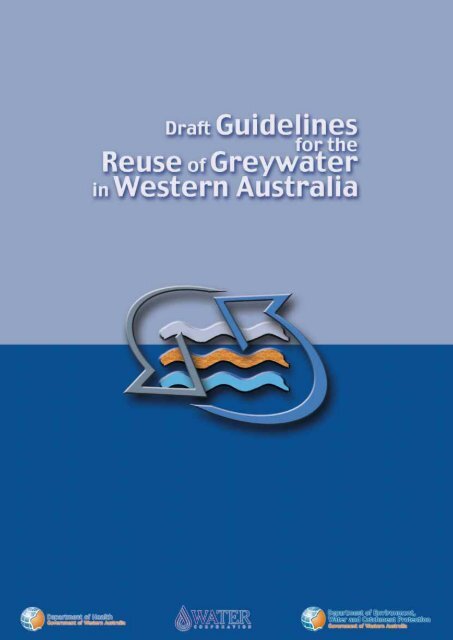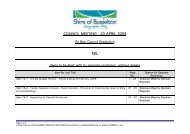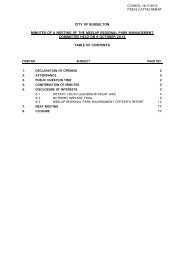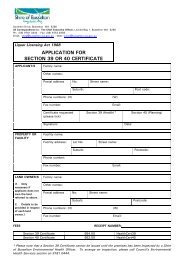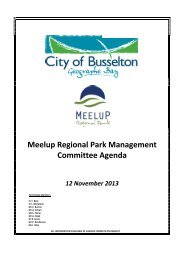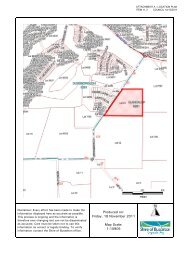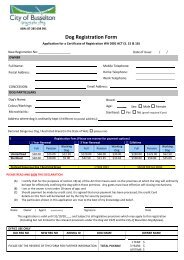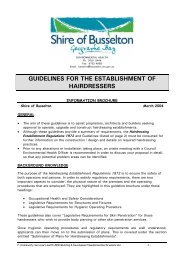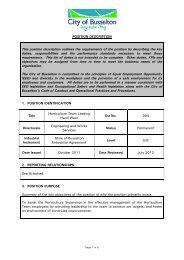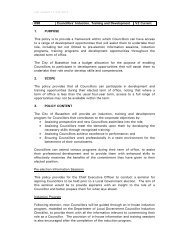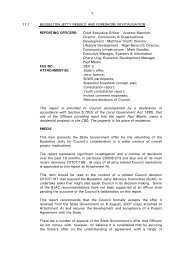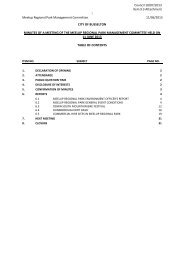Draft Guidelines for the Reuse of Greywater in Western Australia
Draft Guidelines for the Reuse of Greywater in Western Australia
Draft Guidelines for the Reuse of Greywater in Western Australia
You also want an ePaper? Increase the reach of your titles
YUMPU automatically turns print PDFs into web optimized ePapers that Google loves.
Document released <strong>for</strong> public comment<br />
July 2002<br />
DRAFT<br />
<strong>Draft</strong> <strong>Guidel<strong>in</strong>es</strong> <strong>for</strong> <strong>the</strong> <strong>Reuse</strong> <strong>of</strong> <strong>Greywater</strong> <strong>in</strong> <strong>Western</strong> <strong>Australia</strong><br />
i
DRAFT<br />
This page is <strong>in</strong>tentionally left blank<br />
ii<br />
<strong>Draft</strong> <strong>Guidel<strong>in</strong>es</strong> <strong>for</strong> <strong>the</strong> <strong>Reuse</strong> <strong>of</strong> <strong>Greywater</strong> <strong>in</strong> <strong>Western</strong> <strong>Australia</strong>
FOREWORD<br />
<strong>Western</strong> <strong>Australia</strong> is experienc<strong>in</strong>g water restrictions due to current drought conditions and<br />
<strong>the</strong> critically low levels <strong>of</strong> surface water storage. It is recognised that <strong>in</strong> times such as <strong>the</strong>se<br />
many householders like to conserve water by reus<strong>in</strong>g <strong>the</strong>ir greywater. The objective <strong>of</strong><br />
<strong>the</strong>se guidel<strong>in</strong>es are to assist <strong>in</strong> <strong>the</strong> promotion <strong>of</strong> acceptable greywater reuse practices<br />
and promote conservation <strong>of</strong> our quality ground and surface water supplies.<br />
The guidel<strong>in</strong>es were prepared by <strong>the</strong> Department <strong>of</strong> Health <strong>in</strong> consultation with <strong>the</strong> Water<br />
Corporation and Department <strong>of</strong> Environment, Water and Catchment Protection.<br />
The DRAFT guidel<strong>in</strong>es are be<strong>in</strong>g released <strong>for</strong> a two-month public comment period until<br />
1 September 2002. At <strong>the</strong> end <strong>of</strong> <strong>the</strong> comment period it will be reviewed <strong>in</strong> light <strong>of</strong> <strong>the</strong><br />
submissions received.<br />
Written comments on <strong>the</strong>se draft guidel<strong>in</strong>es may be sent to ei<strong>the</strong>r:<br />
<strong>Draft</strong> <strong>Greywater</strong> <strong>Reuse</strong> <strong>Guidel<strong>in</strong>es</strong> – Comments<br />
Environmental Health Branch<br />
Department <strong>of</strong> Health<br />
PO Box 8172<br />
Perth Bus<strong>in</strong>ess Centre WA 6849<br />
or<br />
Fax: (08) 9388 4910<br />
or<br />
Email: greywater.comments@health.wa.gov.au<br />
Fur<strong>the</strong>r copies <strong>of</strong> <strong>the</strong> draft guidel<strong>in</strong>es are available on <strong>the</strong> Department <strong>of</strong> Health website<br />
at http://www.health.wa.gov.au<br />
DRAFT<br />
<strong>Draft</strong> <strong>Guidel<strong>in</strong>es</strong> <strong>for</strong> <strong>the</strong> <strong>Reuse</strong> <strong>of</strong> <strong>Greywater</strong> <strong>in</strong> <strong>Western</strong> <strong>Australia</strong><br />
iii
TABLE OF CONTENTS<br />
DRAFT<br />
1. INTRODUCTION 1<br />
1.1 CHARACTERISTICS OF HOUSEHOLD GREYWATER 2<br />
1.2 HOUSEHOLD WATER USAGE VOLUMES 3<br />
1.3 COMPOSITION OF HOUSEHOLD GREYWATER 3<br />
2. HEALTH AND SAFETY REQUIREMENTS 5<br />
3. ENVIRONMENTAL IMPACT CONSIDERATIONS 6<br />
4. DESIGN AND PERFORMANCE REQUIREMENTS 8<br />
5. GREYWATER SYSTEM OPTIONS 11<br />
5.1 MANUAL BUCKETING OF GREYWATER 11<br />
5.2 PRIMARY TREATMENT SYSTEMS 11<br />
5.3 SECONDARY TREATMENT SYSTEMS 11<br />
5.4 OTHER TREATMENT SYSTEMS 11<br />
6. GREYWATER IRRIGATION OPTIONS 13<br />
7. DESIGNING A GREYWATER SYSTEM 15<br />
7.1 GENERAL 15<br />
7.2 CALCULATING GREYWATER QUANTITIES 15<br />
7.2.1 For Siz<strong>in</strong>g <strong>Greywater</strong> Tanks 16<br />
7.2.2 For Siz<strong>in</strong>g Irrigation Areas 16<br />
7.3 GREYWATER IRRIGATION SYSTEM SIZING 16<br />
7.3.1 Sub Soil Trench Irrigation Systems 17<br />
7.3.2 Drip or Spray Irrigation Area Siz<strong>in</strong>g 17<br />
7.4 SITING A GREYWATER IRRIGATION SYSTEM 17<br />
7.5 MATERIALS 19<br />
8. SYSTEM MAINTENANCE 20<br />
9. PROCEDURE FOR OBTAINING A PERMIT TO INSTALL A GREYWATER SYSTEM 22<br />
9.1 APPLICATION 22<br />
9.2 INSTALLING A SYSTEM 23<br />
9.3 GREYWATER SYSTEMS APPROVED FOR USE 23<br />
10. DEFINITIONS 25<br />
11. ABBREVIATIONS 26<br />
12. REFERENCES 27<br />
13. BIBLIOGRAPHY 28<br />
APPENDIX 1 – GUIDELINES FOR MANUALLY BUCKETING GREYWATER 29<br />
APPENDIX 2 – EXAMPLE GREYWATER CALCULATIONS 31<br />
APPENDIX 3 – PRIMARY TREATMENT SYSTEMS 32<br />
APPENDIX 4 – SECONDARY TREATMENT SYSTEMS 33<br />
APPENDIX 5 – SUB-SOIL TRENCH IRRIGATION DESIGNS 34<br />
iv<br />
<strong>Draft</strong> <strong>Guidel<strong>in</strong>es</strong> <strong>for</strong> <strong>the</strong> <strong>Reuse</strong> <strong>of</strong> <strong>Greywater</strong> <strong>in</strong> <strong>Western</strong> <strong>Australia</strong>
1. INTRODUCTION<br />
<strong>Greywater</strong> is <strong>the</strong> wastewater generated <strong>in</strong> <strong>the</strong> bathroom, kitchen and laundry. <strong>Greywater</strong><br />
is <strong>the</strong>re<strong>for</strong>e <strong>the</strong> components <strong>of</strong> domestic wastewater, which have not orig<strong>in</strong>ated from <strong>the</strong><br />
toilet.<br />
The opportunity exists <strong>for</strong> greywater to be reused to irrigate gardens. This will reduce <strong>the</strong><br />
demand on quality ground and surface water supplies. Consider<strong>in</strong>g <strong>the</strong> dry environment<br />
<strong>in</strong> many parts <strong>of</strong> <strong>Western</strong> <strong>Australia</strong> and <strong>the</strong> sometimes limited supply <strong>of</strong> water available, it<br />
is important that water is used efficiently and conserved wherever possible. <strong>Reuse</strong> <strong>of</strong><br />
greywater is <strong>the</strong>re<strong>for</strong>e supported and encouraged by Government to help conserve water.<br />
However, this has to be accomplished without compromis<strong>in</strong>g community health, caus<strong>in</strong>g<br />
unacceptable environmental impact, or downgrad<strong>in</strong>g <strong>the</strong> amenity <strong>of</strong> our residential areas.<br />
<strong>Greywater</strong> must be reused <strong>in</strong> a beneficial manner <strong>for</strong> landscap<strong>in</strong>g (ie. to <strong>the</strong> plant<br />
rootzone) ra<strong>the</strong>r than simply disposal at a depth, which would not benefit landscap<strong>in</strong>g.<br />
<strong>Greywater</strong> can conta<strong>in</strong> pathogenic microorganisms <strong>in</strong>clud<strong>in</strong>g bacteria, protozoa, viruses<br />
and parasites <strong>in</strong> concentrations high enough to present a health risk. There<strong>for</strong>e, a level <strong>of</strong><br />
caution must be exercised with greywater reuse. This can be achieved by not allow<strong>in</strong>g<br />
unnecessary human contact with greywater, or by treat<strong>in</strong>g <strong>the</strong> greywater to remove or<br />
destroy <strong>the</strong> microorganisms.<br />
<strong>Greywater</strong> also conta<strong>in</strong>s oils, fats, detergents, soaps, nutrients, salts and particles <strong>of</strong> hair,<br />
food and l<strong>in</strong>t, which can impact on operational per<strong>for</strong>mance and life <strong>of</strong> a greywater<br />
irrigation system. If <strong>the</strong>se contam<strong>in</strong>ants aren’t managed correctly <strong>the</strong>y can degrade soil<br />
structure, clog groundwater flow paths or even cause non wett<strong>in</strong>g characteristics <strong>in</strong><br />
garden soils.<br />
A clear understand<strong>in</strong>g <strong>of</strong> <strong>the</strong> potential health risks, operational problems and<br />
environmental impacts that can be caused by improperly designed greywater treatment<br />
and land application systems, is necessary to ensure only suitably designed greywater<br />
treatment and land application systems are permitted. There will be a cost to design,<br />
<strong>in</strong>stall and ma<strong>in</strong>ta<strong>in</strong> such greywater reuse systems if <strong>the</strong>y are to protect public health and<br />
be environmentally susta<strong>in</strong>able. <strong>Greywater</strong> systems must be designed <strong>for</strong> long term use.<br />
Past experiences have shown that some poorly developed greywater systems will result <strong>in</strong><br />
clogg<strong>in</strong>g <strong>of</strong> <strong>the</strong> soil, odours, blockages and become a burden (f<strong>in</strong>ancial and time) due to<br />
constant ma<strong>in</strong>tenance requirements.<br />
The objective <strong>of</strong> <strong>the</strong>se guidel<strong>in</strong>es is to assist <strong>in</strong> <strong>the</strong> promotion <strong>of</strong> acceptable long term<br />
greywater reuse practice and promote conservation <strong>of</strong> our quality ground and surface<br />
water supplies by:<br />
●<br />
establish<strong>in</strong>g acceptable means <strong>for</strong> greywater reuse as a guide <strong>for</strong> local government,<br />
<strong>in</strong>dustry and homeowners;<br />
DRAFT<br />
<strong>Draft</strong> <strong>Guidel<strong>in</strong>es</strong> <strong>for</strong> <strong>the</strong> <strong>Reuse</strong> <strong>of</strong> <strong>Greywater</strong> <strong>in</strong> <strong>Western</strong> <strong>Australia</strong><br />
1
DRAFT<br />
●<br />
●<br />
●<br />
sett<strong>in</strong>g m<strong>in</strong>imum standards <strong>for</strong> design, <strong>in</strong>stallation and <strong>the</strong> procedures <strong>for</strong> ga<strong>in</strong><strong>in</strong>g<br />
approval <strong>for</strong> greywater reuse system <strong>in</strong>stallations;<br />
safeguard<strong>in</strong>g <strong>the</strong> community from possible disease transmission aris<strong>in</strong>g from improper<br />
greywater reuse; and<br />
ensur<strong>in</strong>g that greywater <strong>in</strong>stallations do not harm <strong>the</strong> environment, cause a nuisance,<br />
are appropriately sited and ma<strong>in</strong>ta<strong>in</strong>ed to a satisfactory standard.<br />
This document considers reuse <strong>of</strong> greywater <strong>in</strong> residential premises, but <strong>the</strong> general<br />
pr<strong>in</strong>ciples may be applied and utilised <strong>for</strong> o<strong>the</strong>r types <strong>of</strong> developments generat<strong>in</strong>g<br />
greywater.<br />
1.1 Characteristics <strong>of</strong> Household <strong>Greywater</strong><br />
The characteristics <strong>of</strong> greywater produced by a household will vary accord<strong>in</strong>g to <strong>the</strong><br />
number <strong>of</strong> occupants, <strong>the</strong> age distribution, lifestyle, health status and water usage<br />
patterns.<br />
There are essentially three different greywater streams, <strong>the</strong>y are:<br />
●<br />
●<br />
●<br />
Bathroom greywater (bath, bas<strong>in</strong>, and shower) contributes about 55% <strong>of</strong> <strong>the</strong> total<br />
greywater volume. Bathroom greywater can be contam<strong>in</strong>ated with hair, soaps,<br />
shampoos, hair dyes, toothpaste, l<strong>in</strong>t, body fats, oils and clean<strong>in</strong>g products. It also<br />
has some faecal contam<strong>in</strong>ation (and <strong>the</strong> associated bacteria and viruses) through<br />
body wash<strong>in</strong>g.<br />
Laundry greywater contributes about 34% <strong>of</strong> <strong>the</strong> total greywater volume.<br />
Wastewater from <strong>the</strong> laundry varies <strong>in</strong> quality from wash water to r<strong>in</strong>se water to<br />
second r<strong>in</strong>se water. Laundry greywater can have faecal contam<strong>in</strong>ation with <strong>the</strong><br />
associated bacteria and viruses, l<strong>in</strong>t, oils, greases, chemicals, soaps, nutrients and<br />
o<strong>the</strong>r compounds.<br />
Kitchen greywater contributes about 11% <strong>of</strong> <strong>the</strong> total greywater volume. Kitchen<br />
greywater is heavily polluted with food particles, cook<strong>in</strong>g oils, grease, detergents,<br />
and o<strong>the</strong>r clean<strong>in</strong>g products such as dishwash<strong>in</strong>g powders. The detergents and<br />
clean<strong>in</strong>g products may be alkal<strong>in</strong>e and conta<strong>in</strong> chemicals that are harmful to soil<br />
structure, plants and groundwater. The solid food particles and fats can solidify and<br />
are not readily broken down by soil organisms, this can result <strong>in</strong> blockages <strong>in</strong> <strong>the</strong><br />
land application system. It can also cause <strong>the</strong> soil to become water repellent. It is<br />
<strong>for</strong> <strong>the</strong>se reasons that kitchen wastewater may not be well suited <strong>for</strong> reuse <strong>in</strong> all<br />
types <strong>of</strong> greywater systems. Kitchen greywater should not be reused via manual<br />
bucket<strong>in</strong>g.<br />
2 <strong>Draft</strong> <strong>Guidel<strong>in</strong>es</strong> <strong>for</strong> <strong>the</strong> <strong>Reuse</strong> <strong>of</strong> <strong>Greywater</strong> <strong>in</strong> <strong>Western</strong> <strong>Australia</strong>
1.2 Household Water Usage Volumes<br />
The average house (based on 3.3 persons per house) uses 337 kilolitres <strong>of</strong> water per year<br />
or approximately 1000 litres each day. This amount will vary accord<strong>in</strong>g to <strong>the</strong> water use<br />
practises <strong>of</strong> <strong>the</strong> household and <strong>the</strong> various percentages are shown <strong>in</strong> figure 1.2.<br />
Figure 1.2: Household Water Usage Source: Water Corporation (2002)<br />
1.3 Composition <strong>of</strong> Household <strong>Greywater</strong><br />
Table 1.3(a) documents <strong>the</strong> microbiological quality (ie <strong>the</strong> number <strong>of</strong> <strong>the</strong>rmotolerant<br />
coli<strong>for</strong>ms) <strong>of</strong> greywater from various sources <strong>in</strong> a residential dwell<strong>in</strong>g.<br />
Thermotolerant coli<strong>for</strong>ms are also known as faecal coli<strong>for</strong>ms (expressed as colony <strong>for</strong>m<strong>in</strong>g<br />
units per 100ml) and are a type <strong>of</strong> micro-organism which typically grow <strong>in</strong> <strong>the</strong> <strong>in</strong>test<strong>in</strong>e <strong>of</strong><br />
warm blooded animals (<strong>in</strong>clud<strong>in</strong>g humans) and are shed <strong>in</strong> <strong>the</strong>ir millions to billions per<br />
gram <strong>of</strong> faeces. A high faecal coli<strong>for</strong>m count is undesirable and <strong>in</strong>dicates a greater chance<br />
<strong>of</strong> human illness and <strong>in</strong>fections develop<strong>in</strong>g through contact with <strong>the</strong> wastewater.<br />
It is useful to bear <strong>in</strong> m<strong>in</strong>d while read<strong>in</strong>g <strong>the</strong> follow<strong>in</strong>g table that typical levels <strong>of</strong><br />
<strong>the</strong>rmotolerant coli<strong>for</strong>ms found <strong>in</strong> raw sewage are <strong>in</strong> <strong>the</strong> order <strong>of</strong> 10 6 to 10 8 cfu/100ml and<br />
from 10 6 to 10 10 cfu/100ml <strong>in</strong> septic tank effluent (ie 10 6 to 10 8 means 1,000,000 to<br />
100,000,000).<br />
DRAFT<br />
<strong>Draft</strong> <strong>Guidel<strong>in</strong>es</strong> <strong>for</strong> <strong>the</strong> <strong>Reuse</strong> <strong>of</strong> <strong>Greywater</strong> <strong>in</strong> <strong>Western</strong> <strong>Australia</strong><br />
3
Table 1.3(a): Faecal Coli<strong>for</strong>m Numbers <strong>in</strong> <strong>Greywater</strong> prior to storage<br />
DRAFT<br />
SOURCE<br />
Bath<strong>in</strong>g/Shower<br />
Laundry Wash<br />
Water<br />
Laundry R<strong>in</strong>se<br />
Water<br />
Kitchen<br />
Comb<strong>in</strong>ed<br />
<strong>Greywater</strong><br />
Rose et. al.<br />
(1991)<br />
6 x 10 3 cfu<br />
126 cfu<br />
25 cfu<br />
6 to 80 cfu A<br />
1.5 x 10 3 cfu B<br />
1.8 x 10 5 to 8 x<br />
10 6 cfu<br />
FAECAL COLIFORMS(cfu)/100ML<br />
Calif. DHS<br />
(1990)<br />
4 x 10 5 MPN<br />
2 x 10 3 -10 7<br />
MPN<br />
Brandes<br />
(1978)<br />
< 10 to 2 x 10 8<br />
The chemical and physical quality <strong>of</strong> greywater compared with raw sewage is shown <strong>in</strong><br />
Table 1.3 (b). The high variability <strong>of</strong> <strong>the</strong> greywater quality is due to factors such as source<br />
<strong>of</strong> water, water use efficiencies <strong>of</strong> appliances and fixtures, <strong>in</strong>dividual habits, products used<br />
(soaps, shampoos, detergents) and o<strong>the</strong>r site specific characteristics.<br />
Table 1.3(b): Typical Composition <strong>of</strong> <strong>Greywater</strong> compared with Raw Sewage<br />
Kapisak et.al<br />
(1992)<br />
6 x 10 3 cfu<br />
200<br />
90 – 290<br />
2. HEALTH AND SAFETY REQUIREMENTS<br />
The health <strong>of</strong> a household is usually reflected <strong>in</strong> <strong>the</strong> wastewater produced. However, a<br />
household enjoy<strong>in</strong>g good health will still excrete pathogenic micro-organisms which are a<br />
normal part <strong>of</strong> <strong>the</strong> gut. All <strong>for</strong>ms <strong>of</strong> greywater are capable <strong>of</strong> transmitt<strong>in</strong>g disease.<br />
Pathogens from greywater may spread by direct contact (i.e, touch<strong>in</strong>g greywater or<br />
<strong>in</strong>hal<strong>in</strong>g <strong>in</strong>fectious water droplets) or <strong>in</strong>directly by consumption <strong>of</strong> contam<strong>in</strong>ated food or<br />
water.<br />
To m<strong>in</strong>imise <strong>the</strong> risk to public health and prevent a nuisance from greywater reuse, <strong>the</strong><br />
follow<strong>in</strong>g requirements apply:<br />
2.1 <strong>Greywater</strong> systems (this does not <strong>in</strong>clude bucket<strong>in</strong>g) must dispose <strong>of</strong> greywater<br />
below <strong>the</strong> ground surface unless treated and dis<strong>in</strong>fected to an appropriate standard<br />
(see Section 6, Table 6.1).<br />
2.2 The system must be designed and operated to exclude human and animal contact<br />
with <strong>the</strong> greywater except as required to ma<strong>in</strong>ta<strong>in</strong> <strong>the</strong> system.<br />
2.3 No cross connection with <strong>the</strong> potable water supply is allowed.<br />
2.4 <strong>Greywater</strong> must not be allowed to enter any stormwater dra<strong>in</strong>age system.<br />
2.5 <strong>Greywater</strong> shall not be used <strong>in</strong> a manner that will result <strong>in</strong> direct contact with<br />
vegetables or o<strong>the</strong>r edible plants. It may be used to irrigate fruit plants where <strong>the</strong><br />
fruit does not make contact with <strong>the</strong> greywater.<br />
2.6 No opportunity <strong>for</strong> mosquito breed<strong>in</strong>g is to exist <strong>in</strong> any part <strong>of</strong> a greywater system,<br />
i.e. <strong>in</strong> conveyance, treatment, storage, soil application.<br />
2.7 If irrigated via sub-strata drippers or above ground sprays each irrigation area shall<br />
have signage effectively caution<strong>in</strong>g those enter<strong>in</strong>g <strong>the</strong> area that greywater is be<strong>in</strong>g<br />
used <strong>for</strong> irrigation. The sign should be on a white background with red letter<strong>in</strong>g at<br />
least 20mm high. The sign shall state:<br />
WARNING<br />
GREYWATER IRRIGATION AREA<br />
DO NOT DRINK – AVOID CONTACT<br />
DRAFT<br />
<strong>Draft</strong> <strong>Guidel<strong>in</strong>es</strong> <strong>for</strong> <strong>the</strong> <strong>Reuse</strong> <strong>of</strong> <strong>Greywater</strong> <strong>in</strong> <strong>Western</strong> <strong>Australia</strong><br />
5
3. ENVIRONMENTAL IMPACT CONSIDERATIONS<br />
DRAFT<br />
Domestic reuse <strong>of</strong> greywater will help <strong>the</strong> environment by reduc<strong>in</strong>g demand on higher<br />
quality bore and scheme waters. However, greywater reuse is only part <strong>of</strong> <strong>the</strong> approach<br />
we need to adopt to protect our water resources. To conserve ground and surface water<br />
resources, even be<strong>for</strong>e consider<strong>in</strong>g greywater reuse, it is essential that water conservation<br />
is practiced. <strong>Greywater</strong> generation should be m<strong>in</strong>imised <strong>for</strong> three important reasons:<br />
● to conserve dr<strong>in</strong>k<strong>in</strong>g water as a precious natural resource;<br />
● to ensure that greywater does not overload <strong>the</strong> <strong>in</strong>stalled greywater land application<br />
system; and<br />
● to m<strong>in</strong>imise land requirements <strong>for</strong> a greywater reuse system.<br />
Various water sav<strong>in</strong>g devices can be used to conserve water, <strong>in</strong>clud<strong>in</strong>g dual flush toilet<br />
cisterns and reduced flow shower heads, dishwashers and wash<strong>in</strong>g mach<strong>in</strong>es. Water may<br />
also be conserved us<strong>in</strong>g a range <strong>of</strong> practices such as shorter showers, turn<strong>in</strong>g <strong>the</strong> tap <strong>of</strong>f<br />
when clean<strong>in</strong>g teeth, ensur<strong>in</strong>g that taps do not cont<strong>in</strong>uously drip, and us<strong>in</strong>g dishwashers<br />
and clo<strong>the</strong>s washers only when <strong>the</strong> load is full. As 47% <strong>of</strong> household water usage is <strong>for</strong><br />
garden water<strong>in</strong>g, a water wise garden can greatly reduce water usage. For more<br />
<strong>in</strong><strong>for</strong>mation on ways to save water <strong>in</strong> <strong>the</strong> home contact <strong>the</strong> Water Corporation.<br />
The Government has committed significant funds to provide <strong>in</strong>fill sewerage to many<br />
unsewered urban areas <strong>in</strong> <strong>Western</strong> <strong>Australia</strong>. This occurred <strong>for</strong> a number <strong>of</strong> reasons<br />
<strong>in</strong>clud<strong>in</strong>g environmental concerns about nutrient impacts from septic tank systems. It<br />
would <strong>the</strong>re<strong>for</strong>e be irresponsible to divert greywater from <strong>the</strong> sewer <strong>for</strong> reuse onsite <strong>in</strong><br />
locations where phosphates from greywater could negatively impact on nearby<br />
environmentally sensitive water bodies without suitable protective measures be<strong>in</strong>g<br />
implemented.<br />
To m<strong>in</strong>imise negative impacts on <strong>the</strong> environment from greywater reuse, <strong>the</strong> follow<strong>in</strong>g<br />
requirements apply:<br />
3.1 <strong>Greywater</strong> must be conta<strong>in</strong>ed with<strong>in</strong> <strong>the</strong> conf<strong>in</strong>es <strong>of</strong> <strong>the</strong> premises on which it is<br />
generated and not be permitted to run<strong>of</strong>f onto neighbour<strong>in</strong>g properties.<br />
3.2 Only products with very low phosphorus content should be used. Phosphorus<br />
content can range from a low content <strong>of</strong> 0.05% up to 10% <strong>in</strong> various detergents.<br />
Native plants (not all) are sensitive to additional phosphorus. Plants <strong>of</strong> <strong>the</strong><br />
Proteaceae family (such as grevillea, hakea, banksia and silky oak) are susceptible<br />
to excess phosphates. These plants are not ideally suited to greywater reuse.<br />
3.3 <strong>Greywater</strong> tends to be slightly alkal<strong>in</strong>e, with a pH range <strong>of</strong> typically between 6.5 and<br />
9.0, and <strong>the</strong> extensive use <strong>of</strong> greywater <strong>for</strong> irrigation could cause <strong>the</strong> soil to become<br />
progressively more alkal<strong>in</strong>e. Shade lov<strong>in</strong>g and acid lov<strong>in</strong>g plants do not like <strong>the</strong><br />
alkal<strong>in</strong>ity <strong>of</strong> greywater. These <strong>in</strong>clude azaleas, camellias, gardenias, begonias, and<br />
ferns.<br />
6 <strong>Draft</strong> <strong>Guidel<strong>in</strong>es</strong> <strong>for</strong> <strong>the</strong> <strong>Reuse</strong> <strong>of</strong> <strong>Greywater</strong> <strong>in</strong> <strong>Western</strong> <strong>Australia</strong>
3.4 Wash<strong>in</strong>g powders that conta<strong>in</strong> sodium salts as bulk<strong>in</strong>g agents should be used<br />
spar<strong>in</strong>gly. High levels <strong>of</strong> sodium can produce sal<strong>in</strong>e greywater. Sodium can damage<br />
soil structure, reduc<strong>in</strong>g <strong>the</strong> air space, giv<strong>in</strong>g it a greasy texture and poor dra<strong>in</strong>age<br />
capability. Products which use potassium salts or liquid concentrates should be<br />
used as <strong>the</strong>y produce better quality, less sal<strong>in</strong>e greywater.<br />
3.5 Detergents and powder cleansers conta<strong>in</strong> boron and should be used spar<strong>in</strong>gly, as<br />
boron can be toxic to plants <strong>in</strong> high concentrations and can also be toxic to animals.<br />
The USA Environmental Protection Agency (1992) recommends <strong>the</strong> maximum<br />
concentration <strong>of</strong> boron be 0.75g/L <strong>for</strong> long term use on sensitive plants.<br />
3.6 Try to avoid <strong>the</strong> use <strong>of</strong>:<br />
● bleaches or s<strong>of</strong>teners<br />
● detergents that advertise whiten<strong>in</strong>g, s<strong>of</strong>ten<strong>in</strong>g and enzymatic powers<br />
● detergents with <strong>in</strong>gredients which <strong>in</strong>clude: boron, borax, chlor<strong>in</strong>e, bleach,<br />
sodium perborate and sodium trypochlorite (salts), acids etc<br />
3.7 The follow<strong>in</strong>g materials should not enter a greywater system<br />
● Pa<strong>in</strong>ts, automotive oils and greases etc<br />
● Any matter designated as trade waste or <strong>in</strong>dustrial liquid waste.<br />
3.8 In sandy soils where <strong>the</strong> phosphorous retention <strong>in</strong>dex (PRI) <strong>of</strong> <strong>the</strong> soil is less than 5<br />
<strong>the</strong> greywater systems should be <strong>in</strong>stalled more than 100 metres away from a<br />
wetland, streamflow (<strong>in</strong>clud<strong>in</strong>g stormwater dra<strong>in</strong>s) or o<strong>the</strong>r water sensitive<br />
ecosystems. In<strong>for</strong>mation about local water features can be obta<strong>in</strong>ed from<br />
Department <strong>of</strong> Environment, Water and Catchment Protection (DEWCP).<br />
3.9 System flow rates on coarse sandy soil/gravel should be carefully designed to avoid<br />
greywater leach<strong>in</strong>g <strong>in</strong>to groundwater or surface water bodies.<br />
DRAFT<br />
<strong>Draft</strong> <strong>Guidel<strong>in</strong>es</strong> <strong>for</strong> <strong>the</strong> <strong>Reuse</strong> <strong>of</strong> <strong>Greywater</strong> <strong>in</strong> <strong>Western</strong> <strong>Australia</strong><br />
7
4. DESIGN AND PERFORMANCE REQUIREMENTS<br />
DRAFT<br />
All greywater systems are an “Apparatus <strong>for</strong> <strong>the</strong> Treatment <strong>of</strong> Sewage” as def<strong>in</strong>ed under<br />
section 3 <strong>of</strong> <strong>the</strong> Health Act 1911, and as such <strong>the</strong>ir design, manufacture and use must<br />
be approved by <strong>the</strong> Executive Director, Public Health.<br />
A greywater reuse system is to be designed, constructed, operated and ma<strong>in</strong>ta<strong>in</strong>ed <strong>in</strong><br />
accordance with <strong>the</strong> follow<strong>in</strong>g:<br />
4.l All primary greywater reuse systems are to <strong>in</strong>corporate below ground irrigation<br />
methods. Secondary treated greywater if dis<strong>in</strong>fected can be irrigated above <strong>the</strong><br />
ground surface (see Table 6.1).<br />
4.2 All primary treatment greywater systems must <strong>in</strong>corporate a sedimentation tank to<br />
remove fats, greases and solids.<br />
<strong>Greywater</strong> systems that treat all greywater streams (ie kitchen, bathroom and<br />
laundry) must have a sedimentation tank that has a m<strong>in</strong>imum volume <strong>of</strong> 1820L.<br />
<strong>Greywater</strong> systems that treat bathroom and/or laundry greywater only must be<br />
designed to provide at least 24 hour comb<strong>in</strong>ed retention <strong>for</strong> <strong>the</strong> daily flow <strong>of</strong><br />
greywater (ie: double <strong>the</strong> daily flow), with 40 litres/person/year <strong>of</strong> capacity allowed<br />
<strong>for</strong> scum and sludge accumulation.<br />
4.3 Variations to <strong>the</strong> above design requirements will be considered <strong>for</strong> greywater<br />
systems proposed by manufacturers. These systems will require demonstration that<br />
effective long term operation <strong>of</strong> <strong>the</strong> system can be expected. Depend<strong>in</strong>g on <strong>the</strong><br />
nature <strong>of</strong> <strong>the</strong> system, demonstration <strong>of</strong> this may require <strong>the</strong> system be subjected to<br />
a per<strong>for</strong>mance trial.<br />
4.4 Manufacturers <strong>of</strong> mechanical greywater reuse systems must adequately<br />
demonstrate to <strong>the</strong> satisfaction <strong>of</strong> <strong>the</strong> Department <strong>of</strong> Health that <strong>the</strong> system can be<br />
operated effectively <strong>in</strong> <strong>the</strong> long term without blockages between servic<strong>in</strong>g, and<br />
provide reliability <strong>for</strong> owners. Depend<strong>in</strong>g on <strong>the</strong> nature <strong>of</strong> <strong>the</strong> product a per<strong>for</strong>mance<br />
trial may be required prior to an approval. Such systems are to be provided with a<br />
manufacturer’s warranty and prescribe which greywater streams <strong>the</strong>y are designed<br />
<strong>for</strong> and detail all owner ma<strong>in</strong>tenance requirements. The Department <strong>of</strong> Health may<br />
require that certa<strong>in</strong> designs only be permitted if ma<strong>in</strong>ta<strong>in</strong>ed by an authorised<br />
ma<strong>in</strong>tenance person (eg: <strong>the</strong> manufacturer) and require <strong>for</strong>mal ma<strong>in</strong>tenance<br />
contract arrangements be put <strong>in</strong>to place.<br />
4.5 Irrigation l<strong>in</strong>es (eg: dripper emitters, trickle systems) must be suitable <strong>for</strong> long term<br />
operation, hav<strong>in</strong>g regard <strong>for</strong> <strong>the</strong> likely greywater quality from <strong>the</strong> treatment system.<br />
4.6 All greywater reuse systems <strong>in</strong> sewered locations must have a sewer diversion or<br />
sewer overflow device fitted.<br />
8 <strong>Draft</strong> <strong>Guidel<strong>in</strong>es</strong> <strong>for</strong> <strong>the</strong> <strong>Reuse</strong> <strong>of</strong> <strong>Greywater</strong> <strong>in</strong> <strong>Western</strong> <strong>Australia</strong>
4.7 The design <strong>of</strong> all sewer diversion or overflow devices must be approved by <strong>the</strong> Water<br />
Corporation and all devices must be designed and <strong>in</strong>stalled <strong>in</strong> a manner that allows<br />
<strong>the</strong> flow <strong>of</strong> greywater to <strong>the</strong> irrigation system to cease when overflow or diversion<br />
commences.<br />
4.8 <strong>Greywater</strong> connections must be designed and <strong>in</strong>stalled to prevent sewer gases from<br />
enter<strong>in</strong>g <strong>the</strong> property. All plumb<strong>in</strong>g works must be carried out by a licensed plumber<br />
<strong>in</strong> accordance with <strong>the</strong> Metropolitan Water Supply Sewerage and Dra<strong>in</strong>age By-laws<br />
1981.<br />
4.9 All treatment tanks and pump pits must comply with <strong>the</strong> structural and access<br />
requirements <strong>of</strong> AS 1546.1 – “Onsite Domestic Wastewater Management: Septic<br />
Tanks”.<br />
4.10 Systems <strong>in</strong>corporat<strong>in</strong>g a irrigation pump must have a m<strong>in</strong>imum pump pit capacity<br />
<strong>of</strong> 250L if <strong>the</strong>y are fitted with an overflow to sewer, or 250L plus one days reserve on<br />
unsewered properties.<br />
4.11 Systems <strong>in</strong>corporat<strong>in</strong>g a irrigation pump must be fitted with a high water level<br />
warn<strong>in</strong>g device, to warn <strong>of</strong> pump failure or system blockage. For systems with an<br />
overflow to sewer this should trigger prior to overflow to sewer occurr<strong>in</strong>g, and <strong>for</strong><br />
systems without sewer overflow at <strong>the</strong> 250L level.<br />
4.12 A person with suitable qualifications and experience must design sub-soil pump<br />
pressurised trench irrigation systems. The system must have manifold l<strong>in</strong>es not less<br />
than 40mm <strong>in</strong> diameter and laterals <strong>of</strong> not less than 25mm <strong>in</strong> diameter with not less<br />
than 3mm diameter holes spaced to give uni<strong>for</strong>m distribution.<br />
4.13 Systems must have sufficient irrigation area to ensure long term per<strong>for</strong>mance, tak<strong>in</strong>g<br />
soil types and likely greywater volumes <strong>in</strong>to consideration.<br />
4.14 Systems must be designed to avoid above ground pool<strong>in</strong>g <strong>of</strong> greywater after it’s<br />
application to <strong>the</strong> soil.<br />
4.15 Systems must be designed to avoid <strong>the</strong> likelihood <strong>of</strong> blockage, leakage or overflow<br />
<strong>in</strong> any part <strong>of</strong> <strong>the</strong> system.<br />
4.16 Systems must have simply operated ma<strong>in</strong>tenance access po<strong>in</strong>ts, with security<br />
aga<strong>in</strong>st unauthorised access.<br />
4.17 Systems must be ventilated to avoid accumulation <strong>of</strong> foul air or its entry to build<strong>in</strong>gs<br />
or o<strong>the</strong>rwise caus<strong>in</strong>g a nuisance. Vents shall be constructed as per AS 3500<br />
National Plumb<strong>in</strong>g and Dra<strong>in</strong>age Code to avoid accumulation <strong>of</strong> foul air or its entry<br />
to build<strong>in</strong>g or o<strong>the</strong>rwise caus<strong>in</strong>g a nuisance. Vent cowls shall be suitably screened<br />
to prevent entry by mosquitoes, flies and verm<strong>in</strong>.<br />
DRAFT<br />
<strong>Draft</strong> <strong>Guidel<strong>in</strong>es</strong> <strong>for</strong> <strong>the</strong> <strong>Reuse</strong> <strong>of</strong> <strong>Greywater</strong> <strong>in</strong> <strong>Western</strong> <strong>Australia</strong><br />
9
4.18 <strong>Greywater</strong> must undergo treatment to remove material that may clog pumps, block<br />
pipes and drippers, clog soil or place too many pollutant loads <strong>in</strong> <strong>the</strong> soil.<br />
DRAFT<br />
4.19 Storage o<strong>the</strong>r than that required <strong>for</strong> treatment is to be avoided.<br />
4.20 <strong>Reuse</strong> <strong>of</strong> greywater via sub-strata and sub-surface micro-drip irrigation must comply<br />
with <strong>the</strong> requirements <strong>of</strong> <strong>the</strong> Department <strong>of</strong> Health, <strong>Western</strong> <strong>Australia</strong> (2001) “Code<br />
<strong>of</strong> Practice <strong>for</strong> <strong>the</strong> Design, Manufacture, Installation and Operation <strong>of</strong> Aerobic<br />
Treatment Units (ATU’s) Serv<strong>in</strong>g S<strong>in</strong>gle Dwell<strong>in</strong>gs – Dripper Irrigation Disposal<br />
Criteria”.<br />
4.21 Systems that physically capture/filter out solids from specific greywater streams prior<br />
to irrigation and require ongo<strong>in</strong>g owner <strong>in</strong>put to clean out filters etc, will only be<br />
permitted <strong>in</strong> sewered areas when <strong>the</strong>ir design <strong>in</strong>corporates: an automatic sewer<br />
overflow which occurs when <strong>the</strong> filter becomes clogged, pump fails; or a sewer<br />
diversion device is <strong>in</strong>stalled prior to <strong>the</strong> system. Such systems are not permitted <strong>in</strong><br />
unsewered locations unless <strong>the</strong>y are fitted with an overflow or pre-system divertor to<br />
an onsite wastewater system designed to receive all wastewater.<br />
10 <strong>Draft</strong> <strong>Guidel<strong>in</strong>es</strong> <strong>for</strong> <strong>the</strong> <strong>Reuse</strong> <strong>of</strong> <strong>Greywater</strong> <strong>in</strong> <strong>Western</strong> <strong>Australia</strong>
5. GREYWATER SYSTEM OPTIONS<br />
<strong>Greywater</strong> reuse methods can range from low cost methods such as <strong>the</strong> manual bucket<strong>in</strong>g<br />
<strong>of</strong> greywater from <strong>the</strong> laundry trough or bathtubs, to primary treatment methods that<br />
coarsely screen oils, greases and solids from <strong>the</strong> greywater be<strong>for</strong>e irrigation via small<br />
trench systems, to more expensive secondary treatment systems that treat and dis<strong>in</strong>fect<br />
<strong>the</strong> greywater to a high standard be<strong>for</strong>e irrigat<strong>in</strong>g it via microdrip or spray systems. The<br />
choice <strong>of</strong> system will be dependant on a number <strong>of</strong> factors <strong>in</strong>clud<strong>in</strong>g whe<strong>the</strong>r a new<br />
system is be<strong>in</strong>g <strong>in</strong>stalled or a disused wastewater system is be<strong>in</strong>g converted because <strong>the</strong><br />
property has been connected to sewer.<br />
Options <strong>for</strong> reus<strong>in</strong>g greywater are listed below.<br />
5.1 Manual bucket<strong>in</strong>g <strong>of</strong> greywater<br />
In its simplest <strong>for</strong>m, manually irrigat<strong>in</strong>g (eg. bucket<strong>in</strong>g laundry wastewater) to absorptive<br />
soils is acceptable provided that relevant health and safety conditions are complied with.<br />
These are detailed <strong>in</strong> Appendix 1.<br />
5.2 Primary Treatment Systems<br />
Primary treatment methods use a sedimentation tank to coarsely screen out oils/greases<br />
and solids prior to irrigation via sub-soil trench irrigation systems that are suitable to<br />
receive <strong>the</strong> primary treated greywater. These systems are likely to be considered <strong>the</strong> most<br />
economically attractive <strong>for</strong> greywater reuse because <strong>the</strong>y require only m<strong>in</strong>imal<br />
ma<strong>in</strong>tenance and generally do not rely heavily on electricity or chemicals to operate. The<br />
basic requirements and examples <strong>of</strong> <strong>the</strong>se systems are given <strong>in</strong> Appendix 3.<br />
5.3 Secondary Treatment Systems<br />
Secondary treatment systems fur<strong>the</strong>r treat <strong>the</strong> greywater to remove more <strong>of</strong> <strong>the</strong><br />
oils/greases and solids than <strong>in</strong> primary treatment. This allows secondary treated greywater<br />
to be irrigated via micro-drip or surface irrigation methods (where dis<strong>in</strong>fected), without <strong>the</strong><br />
pipes becom<strong>in</strong>g quickly clogged. These systems are generally more expensive, due to <strong>the</strong><br />
<strong>in</strong>itial establishment costs associated with <strong>the</strong> fur<strong>the</strong>r treatment needs and <strong>the</strong> ongo<strong>in</strong>g<br />
ma<strong>in</strong>tenance costs. However, <strong>the</strong> treatment level enables a much more conventional<br />
surface irrigation system and less health risk with human contact. The basic requirements<br />
and an example <strong>of</strong> a system are given <strong>in</strong> Appendix 4.<br />
5.4 O<strong>the</strong>r Treatment Systems<br />
O<strong>the</strong>r examples <strong>of</strong> greywater reuse systems that do not <strong>in</strong>corporate typical primary or<br />
secondary treatment tank systems are considered <strong>in</strong> a number <strong>of</strong> worldwide greywater<br />
publications. Examples might <strong>in</strong>clude systems that physically capture/filter out solids from<br />
specific greywater streams prior to irrigation and will require ongo<strong>in</strong>g householder<br />
ma<strong>in</strong>tenance to regularly clean filters. It is likely that with <strong>the</strong> <strong>in</strong>troduction <strong>of</strong> <strong>the</strong>se<br />
guidel<strong>in</strong>es, <strong>in</strong>terest <strong>in</strong> <strong>the</strong> use <strong>of</strong> such products will occur. It is also anticipated that<br />
applications will follow from manufacturers seek<strong>in</strong>g approval to allow <strong>the</strong> market<strong>in</strong>g and<br />
use <strong>of</strong> such systems <strong>in</strong> <strong>Western</strong> <strong>Australia</strong> (see section 4).<br />
DRAFT<br />
<strong>Draft</strong> <strong>Guidel<strong>in</strong>es</strong> <strong>for</strong> <strong>the</strong> <strong>Reuse</strong> <strong>of</strong> <strong>Greywater</strong> <strong>in</strong> <strong>Western</strong> <strong>Australia</strong><br />
11
DRAFT<br />
For examples <strong>of</strong> o<strong>the</strong>r systems see <strong>the</strong> “Model <strong>Guidel<strong>in</strong>es</strong> <strong>for</strong> Domestic <strong>Greywater</strong> <strong>Reuse</strong><br />
<strong>for</strong> <strong>Australia</strong>” by <strong>the</strong> Urban Water Research Association <strong>of</strong> <strong>Australia</strong> Research Report 107,<br />
1996.<br />
Be<strong>for</strong>e <strong>the</strong> use or sale <strong>of</strong> greywater systems can be permitted <strong>in</strong> <strong>Western</strong> <strong>Australia</strong> <strong>the</strong>y<br />
must have <strong>the</strong> approval <strong>of</strong> <strong>the</strong> Executive Director, Public Health. Be<strong>for</strong>e approval will be<br />
granted <strong>the</strong> Executive Director, Public Health will need to be satisfied <strong>the</strong> use <strong>of</strong> <strong>the</strong><br />
system and its design are acceptable.<br />
Proponents, designers and <strong>in</strong>ventors <strong>of</strong> greywater systems are encouraged to develop and<br />
make application <strong>for</strong> approval, but such approval will require that <strong>the</strong> suitability <strong>of</strong> such<br />
systems be demonstrated. This may necessitate a per<strong>for</strong>mance trial at <strong>the</strong> proponent’s<br />
expense. Likewise, permission to trial systems will require that proponents satisfy <strong>the</strong><br />
Executive Director, Public Health that <strong>the</strong> basic design concept appears sound.<br />
Please contact <strong>the</strong> Wastewater Management Section <strong>of</strong> Department <strong>of</strong> Health, <strong>Western</strong><br />
<strong>Australia</strong> <strong>for</strong> fur<strong>the</strong>r <strong>in</strong><strong>for</strong>mation about approvals <strong>for</strong> trial<strong>in</strong>g and system design approval.<br />
12 <strong>Draft</strong> <strong>Guidel<strong>in</strong>es</strong> <strong>for</strong> <strong>the</strong> <strong>Reuse</strong> <strong>of</strong> <strong>Greywater</strong> <strong>in</strong> <strong>Western</strong> <strong>Australia</strong>
6. GREYWATER IRRIGATION OPTIONS<br />
The appropriate greywater irrigation method is dependent on <strong>the</strong> treatment level.<br />
Table 6.1: <strong>Greywater</strong> Irrigation Options accord<strong>in</strong>g to Treatment<br />
Treatment<br />
Untreated greywater<br />
Primary treated greywater<br />
(ie through a sedimentation tank)<br />
Secondary treated to a 20 mg/L BOD 5 ,<br />
30 mg/L SS and possible dis<strong>in</strong>fection to<br />
achieve 10 cfu <strong>the</strong>rmotolerant<br />
coli<strong>for</strong>ms/100mL<br />
All disposal methods must be constructed <strong>in</strong> accordance with <strong>the</strong> requirements <strong>of</strong> <strong>the</strong><br />
Health (Treatment <strong>of</strong> Sewage and Disposal <strong>of</strong> Effluent and Liquid Waste) Regulations 1974<br />
and/or <strong>the</strong> AS 1547:2000 – “Onsite Domestic Wastewater Management”.<br />
Irrigation <strong>of</strong> greywater below ground means water is not wasted through w<strong>in</strong>d dispersal,<br />
evaporation and run <strong>of</strong>f and it reduces <strong>the</strong> scope <strong>for</strong> human contact and subsequent risk<br />
to public health.<br />
In sandy soils, soil conditioners should be added to improve <strong>the</strong> soil structure and help<br />
hold <strong>the</strong> greywater close to <strong>the</strong> root zone.<br />
Plants that are deep rooted should be selected, as some shallow rooted plants may not be<br />
able to reach enough water to susta<strong>in</strong> growth. Please contact your local garden centre <strong>for</strong><br />
advice.<br />
There are essentially 5 methods <strong>of</strong> greywater irrigation. These are:<br />
<strong>Greywater</strong> <strong>Reuse</strong> Application<br />
Bucket<strong>in</strong>g<br />
Below ground trench irrigation<br />
Micro drip and spray irrigation<br />
Below ground trench irrigation<br />
1. Sub-Soil Trench Irrigation – this means irrigation by a below ground trench, where <strong>the</strong><br />
base <strong>of</strong> <strong>the</strong> trench does not exceed a depth <strong>of</strong> 400mm below surface. See Appendix 5.<br />
2. Sub-Surface Drip Irrigation – this means irrigation by drip irrigation at a m<strong>in</strong>imum depth<br />
<strong>of</strong> 150mm below ground level. To ensure long life <strong>for</strong> such a system <strong>the</strong> greywater must<br />
be secondary treated to ensure <strong>the</strong> drip irrigation systems do not become blocked.<br />
3. Sub-Strata Drip Irrigation – this means irrigation by drip irrigation where <strong>the</strong> drip<br />
irrigation l<strong>in</strong>es are placed on <strong>the</strong> top <strong>of</strong> <strong>the</strong> ground surface and covered with a m<strong>in</strong>imum<br />
<strong>of</strong> 100mm <strong>of</strong> bark or woodchips. To ensure long life <strong>for</strong> such a system <strong>the</strong> greywater must<br />
be secondary treated to ensure <strong>the</strong> drip irrigation systems do not become blocked.<br />
DRAFT<br />
<strong>Draft</strong> <strong>Guidel<strong>in</strong>es</strong> <strong>for</strong> <strong>the</strong> <strong>Reuse</strong> <strong>of</strong> <strong>Greywater</strong> <strong>in</strong> <strong>Western</strong> <strong>Australia</strong><br />
13
DRAFT<br />
4. Surface Spray Irrigation – means <strong>the</strong> greywater is applied to <strong>the</strong> ground surface from<br />
above ground level. This is only permitted where greywater has been treated and<br />
dis<strong>in</strong>fected <strong>in</strong> accordance with table 6.1 prior to irrigation.<br />
5. Manual Surface Irrigation – The only permitted method <strong>for</strong> this is via manual bucket<strong>in</strong>g<br />
as detailed <strong>in</strong> Appendix 1.<br />
14 <strong>Draft</strong> <strong>Guidel<strong>in</strong>es</strong> <strong>for</strong> <strong>the</strong> <strong>Reuse</strong> <strong>of</strong> <strong>Greywater</strong> <strong>in</strong> <strong>Western</strong> <strong>Australia</strong>
7. DESIGNING A GREYWATER SYSTEM<br />
7.1 General<br />
To design a greywater system, use <strong>of</strong> <strong>the</strong>se guidel<strong>in</strong>es is recommended. It may be<br />
appropriate <strong>for</strong> persons contemplat<strong>in</strong>g a greywater reuse system to consult a wastewater<br />
system designer or o<strong>the</strong>r suitably qualified person to consider <strong>the</strong> options available.<br />
<strong>Greywater</strong> systems will not be permitted where Local Government f<strong>in</strong>ds that <strong>the</strong><br />
<strong>in</strong>stallation <strong>of</strong> a system is not <strong>in</strong> accordance with <strong>the</strong>se <strong>Guidel<strong>in</strong>es</strong> and where:<br />
●<br />
●<br />
●<br />
Insufficient property area is available;<br />
Inappropriate soil conditions exist;<br />
The system design is not one approved by <strong>the</strong> Executive Director, Public Health (see<br />
section 9.3); or<br />
● The property is <strong>in</strong> an environmentally sensitive area (see section 3.8).<br />
To design a greywater system an estimation <strong>of</strong> greywater generation is required and <strong>the</strong><br />
site <strong>the</strong>n needs to be evaluated <strong>for</strong> <strong>the</strong> land irrigation system.<br />
7.2 Calculat<strong>in</strong>g <strong>Greywater</strong> Quantities<br />
To estimate <strong>the</strong> quantity <strong>of</strong> greywater generated <strong>in</strong> a household follow <strong>the</strong> steps below:<br />
First calculate <strong>the</strong> number <strong>of</strong> occupants <strong>of</strong> a home as follows<br />
2 persons <strong>for</strong> first bedroom<br />
1 person per additional bedroom<br />
Next calculate each person’s daily greywater flow allocation as 112 litres per day*<br />
(* based on 12L <strong>for</strong> kitchen, 38L <strong>for</strong> laundry and 62L <strong>for</strong> bathroom)<br />
<strong>Greywater</strong> flow is based upon <strong>the</strong> number <strong>of</strong> bedrooms ra<strong>the</strong>r than <strong>the</strong> actual number <strong>of</strong><br />
people who currently occupy a dwell<strong>in</strong>g, because <strong>the</strong> number <strong>of</strong> bedrooms will rema<strong>in</strong><br />
constant, while <strong>the</strong> number <strong>of</strong> people may vary over time.<br />
DRAFT<br />
<strong>Draft</strong> <strong>Guidel<strong>in</strong>es</strong> <strong>for</strong> <strong>the</strong> <strong>Reuse</strong> <strong>of</strong> <strong>Greywater</strong> <strong>in</strong> <strong>Western</strong> <strong>Australia</strong><br />
15
DRAFT<br />
7.2.1 For Siz<strong>in</strong>g <strong>Greywater</strong> Tanks<br />
<strong>Greywater</strong> systems that treat all greywater streams (ie kitchen, bathroom and laundry)<br />
must have a sedimentation tank that has a m<strong>in</strong>imum volume <strong>of</strong> 1820L.<br />
<strong>Greywater</strong> systems that only treat bathroom and/or laundry greywater must be designed<br />
to provide at least 24 hour comb<strong>in</strong>ed retention <strong>for</strong> <strong>the</strong> daily flow <strong>of</strong> greywater (ie: double<br />
<strong>the</strong> daily flow), with 40 litres/person/year <strong>of</strong> capacity allowed <strong>for</strong> scum and sludge<br />
accumulation.<br />
For example:<br />
3 bedroom house reus<strong>in</strong>g laundry water only, <strong>the</strong> daily greywater is calculated as follows<br />
= 4 persons @ 38L/person/day<br />
= 152 litres daily greywater flow<br />
There<strong>for</strong>e <strong>the</strong> capacity <strong>of</strong> tank required is<br />
152L + 24 hour comb<strong>in</strong>ed retention (ie: double <strong>the</strong> daily flow)<br />
= 152L x 2<br />
= 304L<br />
plus 40L sludge accumulation x number <strong>of</strong> persons<br />
= 40L x 4persons<br />
=160 litres<br />
= 464L tank capacity required<br />
7.2.2 For Siz<strong>in</strong>g Irrigation Areas<br />
The irrigation area is sized us<strong>in</strong>g <strong>the</strong> daily flow only.<br />
For example:<br />
3 bedroom house reus<strong>in</strong>g laundry water only<br />
= 4 persons @ 38 litres/day<br />
= 152 litres daily greywater flow<br />
See appendix 2 <strong>for</strong> more example calculations.<br />
7.3 <strong>Greywater</strong> Irrigation System Siz<strong>in</strong>g<br />
<strong>Greywater</strong> irrigation systems are sized on whe<strong>the</strong>r <strong>the</strong>y use sub-soil trench irrigation<br />
methods or drip/spray irrigation methods. Systems are sized on <strong>the</strong> capability <strong>of</strong> <strong>the</strong> soil<br />
to receive <strong>the</strong> greywater (ie <strong>the</strong> load<strong>in</strong>g <strong>in</strong>filtration rate) and <strong>the</strong> estimated daily greywater<br />
flow.<br />
The permeability <strong>of</strong> <strong>the</strong> soil is to be determ<strong>in</strong>ed <strong>in</strong> accordance with <strong>the</strong> requirements <strong>of</strong><br />
<strong>the</strong> Health (Treatment <strong>of</strong> Sewage and Disposal <strong>of</strong> Effluent and Liquid Waste) Regulations<br />
1974.<br />
16 <strong>Draft</strong> <strong>Guidel<strong>in</strong>es</strong> <strong>for</strong> <strong>the</strong> <strong>Reuse</strong> <strong>of</strong> <strong>Greywater</strong> <strong>in</strong> <strong>Western</strong> <strong>Australia</strong>
7.3.1 Sub Soil Trench Irrigation Systems<br />
The size <strong>of</strong> <strong>the</strong> greywater irrigation trench is calculated us<strong>in</strong>g <strong>the</strong> follow<strong>in</strong>g equation:<br />
L =<br />
V<br />
______<br />
LIR x A<br />
Where:<br />
L = length <strong>of</strong> trench <strong>in</strong> metres<br />
V = daily greywater volume <strong>in</strong> litres/day<br />
LIR = Load<strong>in</strong>g Infiltration Rate <strong>in</strong> litres/metre 2 /day (related to permeability <strong>of</strong> <strong>the</strong> soil)<br />
A = surface area <strong>of</strong> <strong>the</strong> trench <strong>in</strong> m 2 (i.e. <strong>the</strong> sides below <strong>the</strong> <strong>in</strong>vert <strong>of</strong> <strong>the</strong> distribution pipe<br />
and base <strong>of</strong> <strong>the</strong> trench per l<strong>in</strong>eal metre)<br />
Table 7.3 – <strong>Greywater</strong> Infiltration Rates<br />
TIME FOR WATER TO<br />
FALL 25 mm**<br />
(m<strong>in</strong>utes)<br />
1 to 5<br />
More than 5 to 60<br />
More than 60<br />
SOIL TEXTURE<br />
Sand<br />
Loams or gravels<br />
Impervious Clays<br />
LOADING INFILTRATION RATE<br />
(litres per m 2 per day)<br />
Non-alternat<strong>in</strong>g<br />
Alternat<strong>in</strong>g System<br />
System<br />
30<br />
15<br />
20<br />
10<br />
As approved by <strong>the</strong><br />
Executive Director, Public Health.<br />
** a procedure which measures soil permeability by record<strong>in</strong>g <strong>the</strong> time taken <strong>for</strong> water <strong>in</strong> a<br />
300mm x 300mm hole to fall 25mm, see Schedule 8 <strong>of</strong> <strong>the</strong> Health (Treatment <strong>of</strong> Sewage and Disposal <strong>of</strong><br />
Effluent and Liquid Waste) Regulations 1974 <strong>for</strong> a full explanation <strong>of</strong> <strong>the</strong> method.<br />
7.3.2 Drip or Spray Irrigation Area Siz<strong>in</strong>g<br />
The required irrigation area size should be calculated on <strong>the</strong> basis <strong>of</strong> 10 litres/m 2 /day <strong>in</strong><br />
sand and gravel/loam or <strong>for</strong> o<strong>the</strong>r soils <strong>in</strong> accordance with AS 1547:2000 – “Onsite<br />
Domestic Wastewater Management”.<br />
7.4 Sit<strong>in</strong>g a <strong>Greywater</strong> Irrigation System<br />
Once <strong>the</strong> greywater irrigation system has been correctly sized, identification <strong>of</strong> a suitable<br />
location <strong>for</strong> sit<strong>in</strong>g <strong>the</strong> system <strong>in</strong> <strong>the</strong> garden needs to be considered. It must be located to<br />
ensure <strong>the</strong> protection <strong>of</strong> build<strong>in</strong>gs, structures and adjo<strong>in</strong><strong>in</strong>g properties. A range <strong>of</strong><br />
m<strong>in</strong>imum set back distances are necessary from drip/spray irrigation areas, tanks and<br />
subsoil irrigation trenches. Clearance from build<strong>in</strong>gs, boundaries, water supplies and<br />
subsoil trenches must be <strong>in</strong> accordance with <strong>the</strong> Health (Treatment <strong>of</strong> Sewage and<br />
Disposal <strong>of</strong> Effluent and Liquid Waste) Regulations 1974.<br />
DRAFT<br />
<strong>Draft</strong> <strong>Guidel<strong>in</strong>es</strong> <strong>for</strong> <strong>the</strong> <strong>Reuse</strong> <strong>of</strong> <strong>Greywater</strong> <strong>in</strong> <strong>Western</strong> <strong>Australia</strong><br />
17
<strong>Greywater</strong> irrigation systems must also be sufficiently distanced from environmental<br />
features or water supplies. Indicative setback distances are given below.<br />
DRAFT<br />
Table 7.4 Example M<strong>in</strong>imum Setback Distances<br />
Note:<br />
Item<br />
Boundaries<br />
Build<strong>in</strong>gs<br />
Sub-soil Dra<strong>in</strong>s<br />
Bores* - <strong>in</strong>tended <strong>for</strong><br />
human consumption<br />
Paths, drives, carports etc.<br />
Wetlands and water<br />
dependent ecosystems**<br />
Drip Irrigation<br />
area<br />
(metres)<br />
0.5<br />
0.5<br />
3.0<br />
30.0<br />
0.5<br />
100<br />
Spray Irrigation<br />
area<br />
(metres)<br />
1.8<br />
1.8<br />
3.0<br />
30.0<br />
1.8<br />
100<br />
Subsoil Irrigation<br />
Trenches<br />
(metres)<br />
1.8<br />
1.8<br />
6.0<br />
30.0<br />
0.5<br />
100<br />
Drip distance measured from pipework.<br />
Spray distance measured from edge <strong>of</strong> spray plume.<br />
*Only EDPH may vary this setback requirement.<br />
** For description <strong>of</strong> Public Dr<strong>in</strong>k<strong>in</strong>g Water Supply Areas (PDWSA) or wetland position<strong>in</strong>g contact<br />
DEWCP.<br />
All greywater irrigation systems (ie, <strong>the</strong> dripper l<strong>in</strong>e or base <strong>of</strong> trench) must achieve a<br />
m<strong>in</strong>imum <strong>of</strong> 500 mm clearance above <strong>the</strong> highest seasonal groundwater level.<br />
Below ground greywater tanks must be a m<strong>in</strong>imum <strong>of</strong> 1.2 metres from any boundary or<br />
build<strong>in</strong>g/ structure.<br />
Trenches should be <strong>in</strong>stalled <strong>in</strong> a manner that ensures even distribution. For example,<br />
trenches must be laid level and constructed <strong>in</strong> such a manner that preferential flow to one<br />
portion <strong>of</strong> a trench will not occur.<br />
Where <strong>the</strong> land gradient is greater than 1:10 and it is practicable, <strong>the</strong> surface irrigation<br />
disposal area may need to be modified by bench<strong>in</strong>g or bund<strong>in</strong>g etc and/or <strong>in</strong>creased <strong>in</strong><br />
size to prevent run<strong>of</strong>f. If <strong>the</strong> land gradient is greater than 1:5 <strong>the</strong>n <strong>the</strong> application will be<br />
<strong>in</strong>dividually assessed by <strong>the</strong> Local Government.<br />
Entry <strong>of</strong> excessive stormwater to a greywater irrigation area should be m<strong>in</strong>imised via<br />
diversion dra<strong>in</strong>s.<br />
The irrigation area should be planted with appropriate grasses or o<strong>the</strong>r groundcover and<br />
shrubs that tolerate wet conditions and have a high evapo-transpiration capacity. Ask your<br />
local Garden centre <strong>for</strong> fur<strong>the</strong>r <strong>in</strong><strong>for</strong>mation on plant species.<br />
18 <strong>Draft</strong> <strong>Guidel<strong>in</strong>es</strong> <strong>for</strong> <strong>the</strong> <strong>Reuse</strong> <strong>of</strong> <strong>Greywater</strong> <strong>in</strong> <strong>Western</strong> <strong>Australia</strong>
7.5 Materials<br />
All drip irrigation pipework and fitt<strong>in</strong>gs must comply with AS 1477 – “PVC Pipes and<br />
fitt<strong>in</strong>gs <strong>for</strong> pressure applications” or AS 2698.2 – “Per<strong>for</strong>ated effluent pipe and associated<br />
fitt<strong>in</strong>gs <strong>for</strong> sewerage applications”.<br />
The distribution pipe used <strong>in</strong> gravity fed sub-soil trenches should have a m<strong>in</strong>imum <strong>in</strong>ternal<br />
diameter not less than 80mm <strong>in</strong> accordance with AS 2439 – “Per<strong>for</strong>ated plastic dra<strong>in</strong>age<br />
and effluent pipe and fitt<strong>in</strong>gs”. A porous soakage hose or slotted agricultural pipe is not<br />
acceptable <strong>for</strong> distribution <strong>of</strong> primary treated greywater <strong>in</strong> trench systems due to <strong>the</strong><br />
likelihood <strong>of</strong> clogg<strong>in</strong>g.<br />
DRAFT<br />
<strong>Draft</strong> <strong>Guidel<strong>in</strong>es</strong> <strong>for</strong> <strong>the</strong> <strong>Reuse</strong> <strong>of</strong> <strong>Greywater</strong> <strong>in</strong> <strong>Western</strong> <strong>Australia</strong><br />
19
8. SYSTEM MAINTENANCE<br />
DRAFT<br />
The success <strong>of</strong> a greywater reuse system will depend on an <strong>in</strong>dividual’s ef<strong>for</strong>ts <strong>in</strong><br />
ma<strong>in</strong>ta<strong>in</strong><strong>in</strong>g <strong>the</strong> system. Once a greywater system is <strong>in</strong>stalled it becomes <strong>the</strong><br />
householder’s responsibility to ensure it is managed <strong>in</strong> accordance with <strong>the</strong><br />
manufacturer’s <strong>in</strong>structions. The owner should also ensure that <strong>the</strong> greywater system is<br />
ma<strong>in</strong>ta<strong>in</strong>ed <strong>in</strong> good work<strong>in</strong>g order at all times. Any defect must be rectified as soon as it<br />
becomes apparent.<br />
Some greywater systems require regular ma<strong>in</strong>tenance e.g. weekly clean<strong>in</strong>g or replac<strong>in</strong>g<br />
filters, periodic desludg<strong>in</strong>g, manually divert<strong>in</strong>g greywater back to sewer <strong>in</strong> w<strong>in</strong>ter and<br />
flush<strong>in</strong>g <strong>of</strong> irrigation l<strong>in</strong>es.<br />
Operation and ma<strong>in</strong>tenance <strong>of</strong> systems will be at a cost to <strong>the</strong> householder. Costs <strong>in</strong>clude<br />
<strong>the</strong> <strong>in</strong>itial construction costs, power to operate pumps, replacement filters, clean<strong>in</strong>g <strong>of</strong><br />
irrigation l<strong>in</strong>es and desludg<strong>in</strong>g <strong>of</strong> sedimentation tanks.<br />
Applicants may be required to undertake certa<strong>in</strong> commitments after system start-up<br />
<strong>in</strong>clud<strong>in</strong>g but not limited to <strong>the</strong> follow<strong>in</strong>g:<br />
●<br />
●<br />
●<br />
●<br />
●<br />
●<br />
●<br />
●<br />
Proper operation through a ma<strong>in</strong>tenance contract between <strong>in</strong>staller and householder.<br />
Weekly ma<strong>in</strong>tenance <strong>of</strong> systems with filter<strong>in</strong>g devices.<br />
Systems with two reuse areas require regular diversion.<br />
Sedimentation tanks require desludg<strong>in</strong>g every 5 years.<br />
Warn<strong>in</strong>g signs should be ma<strong>in</strong>ta<strong>in</strong>ed <strong>in</strong> good order.<br />
The irrigation area should be ma<strong>in</strong>ta<strong>in</strong>ed to prevent <strong>the</strong> entry <strong>of</strong> ra<strong>in</strong>fall run-on.<br />
Test <strong>the</strong> soils <strong>for</strong> pH and sodicity on a regular basis. The addition <strong>of</strong> gypsum may be<br />
needed to help elim<strong>in</strong>ate any build up <strong>of</strong> sodium and magnesium. Also, occasionally<br />
test <strong>for</strong> nutrient levels to make sure <strong>the</strong>re is no overuse <strong>of</strong> fertiliser.<br />
Ensure excess water<strong>in</strong>g does not occur. Over water<strong>in</strong>g can lead to waterlogg<strong>in</strong>g and<br />
plant death.<br />
When conduct<strong>in</strong>g ma<strong>in</strong>tenance (eg clean<strong>in</strong>g filters etc) <strong>in</strong>volv<strong>in</strong>g greywater <strong>the</strong><br />
householder should ensure <strong>the</strong>y:<br />
– avoid direct contact with <strong>the</strong> sk<strong>in</strong> through <strong>the</strong> use <strong>of</strong> rubber gloves and<br />
protective cloth<strong>in</strong>g;<br />
20 <strong>Draft</strong> <strong>Guidel<strong>in</strong>es</strong> <strong>for</strong> <strong>the</strong> <strong>Reuse</strong> <strong>of</strong> <strong>Greywater</strong> <strong>in</strong> <strong>Western</strong> <strong>Australia</strong>
– ensure that cuts, sores, open wounds etc are adequately (waterpro<strong>of</strong> cover<strong>in</strong>g)<br />
protected from any contact with greywater;<br />
– ensure that exposed body areas that come <strong>in</strong>to contact with greywater are<br />
immediately washed;<br />
– do not make contact with <strong>the</strong> mouth or face ei<strong>the</strong>r directly (eg f<strong>in</strong>gers, hands)<br />
or <strong>in</strong>directly (eg smok<strong>in</strong>g) until after wash<strong>in</strong>g hands; and<br />
– do not eat food until hands have been washed thoroughly.<br />
DRAFT<br />
<strong>Draft</strong> <strong>Guidel<strong>in</strong>es</strong> <strong>for</strong> <strong>the</strong> <strong>Reuse</strong> <strong>of</strong> <strong>Greywater</strong> <strong>in</strong> <strong>Western</strong> <strong>Australia</strong><br />
21
DRAFT<br />
Only greywater systems that have been approved by <strong>the</strong> Executive Director, Public Health<br />
under Section 4 <strong>of</strong> <strong>the</strong>se guidel<strong>in</strong>es are approved <strong>for</strong> use <strong>in</strong> <strong>Western</strong> <strong>Australia</strong> (also see<br />
Section 9.3).<br />
Installation <strong>of</strong> an approved greywater system or conversion <strong>of</strong> septic tank systems or<br />
Aerobic Treatment Unit’s (ATU’s) to greywater systems must be approved by <strong>the</strong> Local<br />
Government and will require a <strong>for</strong>mal application be made and all fees paid.<br />
All greywater system applications up to (and <strong>in</strong>clud<strong>in</strong>g) 10 persons are to be made to and<br />
approved by <strong>the</strong> Local Government.<br />
All greywater systems above 10 persons are to be submitted to <strong>the</strong> EDPH <strong>for</strong> approval as<br />
is <strong>the</strong> procedure <strong>for</strong> septic tank applications greater than 540L under Section 4A <strong>of</strong> <strong>the</strong><br />
Health (Treatment <strong>of</strong> Sewage and Disposal <strong>of</strong> Effluent and Liquid Waste) Regulations<br />
1974.<br />
9.1 Application<br />
An Application to Construct or Install an Apparatus <strong>for</strong> <strong>the</strong> Treatment <strong>of</strong> Sewage <strong>for</strong>m can<br />
be obta<strong>in</strong>ed from <strong>the</strong> local government. The applicant must complete <strong>the</strong> relevant<br />
sections, <strong>in</strong>clud<strong>in</strong>g:<br />
●<br />
●<br />
●<br />
●<br />
●<br />
9. PROCEDURE FOR OBTAINING A PERMIT TO<br />
INSTALL A GREYWATER SYSTEM<br />
<strong>Greywater</strong> source and likely volume.<br />
Flow storage and <strong>the</strong> treatment proposed.<br />
Details <strong>of</strong> <strong>the</strong> proposed system.<br />
Soil type and details <strong>of</strong> <strong>the</strong> required area <strong>for</strong> use and <strong>the</strong> area/soakage calculations.<br />
A detailed site layout plan (<strong>in</strong> duplicate or triplicate as <strong>the</strong> case requires) drawn to a<br />
scale <strong>of</strong> 1 <strong>in</strong> 100 show<strong>in</strong>g:<br />
– block dimensions;<br />
– natural ground contours, wells, bores, dams, watercourses and depth to<br />
groundwater;<br />
– exist<strong>in</strong>g and proposed build<strong>in</strong>gs, o<strong>the</strong>r structures and paved areas;<br />
– details and location <strong>of</strong> any diversion trenches to collect surface or migrat<strong>in</strong>g<br />
subsurface water;<br />
– details and location <strong>of</strong> ro<strong>of</strong> water disposal;<br />
– setback distances from boundaries, build<strong>in</strong>gs, surface irrigation disposal area<br />
and o<strong>the</strong>r structures and build<strong>in</strong>gs on <strong>the</strong> boundary alignment; and<br />
– details <strong>of</strong> <strong>the</strong> sewer diversion pipework where this is <strong>in</strong>tended.<br />
22 <strong>Draft</strong> <strong>Guidel<strong>in</strong>es</strong> <strong>for</strong> <strong>the</strong> <strong>Reuse</strong> <strong>of</strong> <strong>Greywater</strong> <strong>in</strong> <strong>Western</strong> <strong>Australia</strong>
●<br />
●<br />
Details <strong>of</strong> <strong>the</strong> treatment and disposal systems <strong>in</strong>clud<strong>in</strong>g:<br />
– proposed location <strong>of</strong> greywater system and reuse area <strong>in</strong>clud<strong>in</strong>g <strong>the</strong> position <strong>of</strong><br />
irrigation l<strong>in</strong>es/trench;<br />
– method <strong>of</strong> construction <strong>of</strong> surface irrigation disposal area bed, <strong>in</strong>clud<strong>in</strong>g <strong>the</strong><br />
materials to be used; and<br />
– where a split irrigation system is used; details <strong>of</strong> mechanisms to ensure an<br />
even discharge to each area and to prevent overload<strong>in</strong>g <strong>of</strong> <strong>in</strong>dividual areas.<br />
The application, <strong>in</strong>spection and local government report fees as currently prescribed.<br />
Failure to supply all requested <strong>in</strong><strong>for</strong>mation will delay consideration <strong>of</strong> <strong>the</strong> application.<br />
As part <strong>of</strong> <strong>the</strong> approval procedure <strong>the</strong> Water Corporation, or o<strong>the</strong>r responsible Sewerage<br />
Service Provider, must agree to <strong>the</strong> diversion <strong>of</strong> greywater from <strong>the</strong> sewer system, <strong>in</strong><br />
regard to possible negative impacts on <strong>the</strong> sewerage system. Local governments shall only<br />
issue approval <strong>for</strong> <strong>the</strong> use <strong>of</strong> greywater systems <strong>in</strong> sewered locations where <strong>the</strong> sewerage<br />
service provider has <strong>in</strong>dicated no objections.<br />
All plumb<strong>in</strong>g work must be undertaken by a licensed plumber who must also obta<strong>in</strong><br />
approval from <strong>the</strong> Sewerage Service Provider <strong>for</strong> any required connection or modification<br />
to <strong>the</strong> plumb<strong>in</strong>g works connected to <strong>the</strong> sewer system.<br />
9.2 Install<strong>in</strong>g a System<br />
Only greywater system designs approved by <strong>the</strong> Executive Director, Public Health are<br />
permitted and it is an <strong>of</strong>fence to commence construction <strong>of</strong> a greywater system without<br />
an approval. Once <strong>the</strong> local government issues an approval <strong>the</strong> system can be<br />
constructed, but not used.<br />
Be<strong>for</strong>e a system can be used, <strong>the</strong> local government must <strong>in</strong>spect <strong>the</strong> system to ensure<br />
that it is <strong>in</strong>stalled correctly be<strong>for</strong>e excavations are refilled. If satisfactory, <strong>the</strong> local<br />
government will issue an approval <strong>for</strong> <strong>the</strong> system to be used. It is an <strong>of</strong>fence to commence<br />
us<strong>in</strong>g <strong>the</strong> system prior to receiv<strong>in</strong>g <strong>the</strong> local government’s approval.<br />
9.3 <strong>Greywater</strong> Systems Approved <strong>for</strong> Use<br />
The follow<strong>in</strong>g greywater reuse systems are approved <strong>for</strong> general use by <strong>the</strong> Executive<br />
Director, Public Health.<br />
●<br />
●<br />
Systems which utilise a sedimentation tank and sub soil trench irrigation systems<br />
constructed as prescribed <strong>in</strong> Section 4.2 and Appendix 3 and sized as detailed <strong>in</strong><br />
Section 7.2;<br />
Systems which convert disused septic tank systems to greywater reuse systems as<br />
detailed <strong>in</strong> Appendix 2 and 3; and<br />
DRAFT<br />
<strong>Draft</strong> <strong>Guidel<strong>in</strong>es</strong> <strong>for</strong> <strong>the</strong> <strong>Reuse</strong> <strong>of</strong> <strong>Greywater</strong> <strong>in</strong> <strong>Western</strong> <strong>Australia</strong><br />
23
●<br />
Systems which convert Aerobic Treatment Units to greywater systems as detailed <strong>in</strong><br />
Appendix 4.<br />
DRAFT<br />
It is anticipated that with <strong>the</strong> release <strong>of</strong> <strong>the</strong>se <strong>Guidel<strong>in</strong>es</strong> new <strong>in</strong>novative greywater system<br />
designs shall be trialed and approved by <strong>the</strong> Executive Director, Public Health.<br />
For a current list <strong>of</strong> approved greywater reuse systems please contact your Local<br />
Government <strong>of</strong>fice or <strong>the</strong> Wastewater Management Section <strong>of</strong> <strong>the</strong> Department <strong>of</strong> Health<br />
on (08) 9388 4932.<br />
24 <strong>Draft</strong> <strong>Guidel<strong>in</strong>es</strong> <strong>for</strong> <strong>the</strong> <strong>Reuse</strong> <strong>of</strong> <strong>Greywater</strong> <strong>in</strong> <strong>Western</strong> <strong>Australia</strong>
10. DEFINITIONS<br />
Absorption – uptake <strong>of</strong> liquid <strong>in</strong>to <strong>the</strong> soil.<br />
BOD 5 (biochemical oxygen demand) – a measure <strong>of</strong> <strong>the</strong> dissolved oxygen required <strong>for</strong> <strong>the</strong><br />
breakdown <strong>of</strong> organic material <strong>in</strong> <strong>the</strong> effluent; usually refers to a five day test which<br />
typically represents 70 – 80% <strong>of</strong> <strong>the</strong> total BOD <strong>in</strong> a sample; expressed <strong>in</strong> milligrams per<br />
litre (mg/L).<br />
Dis<strong>in</strong>fection – a process which reduces <strong>the</strong> number <strong>of</strong> micro-organisms but does not<br />
sterilise or remove all micro-organisms.<br />
<strong>Greywater</strong> – The untreated household wastewater which has not come <strong>in</strong>to contact with<br />
toilet waste (black water). It comes from <strong>the</strong> bath, shower, bathroom wash bas<strong>in</strong>, kitchen<br />
s<strong>in</strong>k, clo<strong>the</strong>s wash<strong>in</strong>g mach<strong>in</strong>e and laundry trough.<br />
<strong>Greywater</strong> <strong>Reuse</strong> – means <strong>the</strong> application <strong>of</strong> greywater <strong>for</strong> a beneficial use. <strong>Reuse</strong> does not<br />
<strong>in</strong>clude disposal at a depth which would not be a beneficial use to plants and gardens.<br />
<strong>Greywater</strong> Systems – consist <strong>of</strong> <strong>the</strong> greywater diversion, treatment, storage and distribution<br />
equipment that reuses greywater <strong>for</strong> garden irrigation.<br />
Pathogens – disease caus<strong>in</strong>g microbes eg viruses, bacteria, helm<strong>in</strong>ths and protozoa.<br />
Phosphorus Retention Index (PRI) – The PRI is def<strong>in</strong>ed as <strong>the</strong> ratio <strong>of</strong> amount <strong>of</strong> P<br />
adsorbed to 5 gram soil, expressed as mg P/kg <strong>of</strong> soil, and concentration <strong>in</strong> solution<br />
(mgP/L) after addition <strong>of</strong> 100 mL <strong>of</strong> a 10 mg/L P solution <strong>in</strong> 0.02 M KCl and equilibration<br />
<strong>for</strong> 18h. The practical scale <strong>of</strong> PRI is from 0 to about 1000 (above which results become<br />
mean<strong>in</strong>gless). A PRI <strong>of</strong> 20 <strong>in</strong>dicates that 5 mg P/L rema<strong>in</strong>s <strong>in</strong> solution after <strong>the</strong> <strong>in</strong>itial<br />
addition <strong>of</strong> 10 mg P/L <strong>in</strong> 100 mL to 5 g <strong>of</strong> soil.<br />
Primary Treatment Systems – These systems utilise a sedimentation tank to coarsely<br />
screen out oils/greases, l<strong>in</strong>t, hair and particles.<br />
Secondary Treatment Systems – These systems treat and dis<strong>in</strong>fect greywater to 20mg/L<br />
BOD 5 , 30mg/L SS standard prior to irrigation via drip and/or surface irrigation methods.<br />
SS (suspended solids) – <strong>in</strong> wastewater analysis, solids reta<strong>in</strong>ed after filtration through a<br />
glass fibre filter paper followed by wash<strong>in</strong>g and dry<strong>in</strong>g at 105 o C, or by centrifug<strong>in</strong>g,<br />
followed by wash<strong>in</strong>g and removal <strong>of</strong> <strong>the</strong> supernatant liquid; expressed <strong>in</strong> milligrams per<br />
litre (mg/L).<br />
Sub-Soil Trench Irrigation – this term is commonly used to denote utilisation <strong>of</strong> wastewater<br />
by <strong>the</strong> trench method below ground level.<br />
DRAFT<br />
<strong>Draft</strong> <strong>Guidel<strong>in</strong>es</strong> <strong>for</strong> <strong>the</strong> <strong>Reuse</strong> <strong>of</strong> <strong>Greywater</strong> <strong>in</strong> <strong>Western</strong> <strong>Australia</strong><br />
25
DRAFT<br />
Sub-Strata Drip Irrigation – this term is commonly used to denote utilisation <strong>of</strong> wastewater<br />
by trickle or micro-drip irrigation where <strong>the</strong> system is placed on <strong>the</strong> top <strong>of</strong> <strong>the</strong> ground<br />
surface and covered with a m<strong>in</strong>imum <strong>of</strong> 100mm <strong>of</strong> approved material (eg bark,<br />
woodchips) placed over <strong>the</strong> irrigation pipework.<br />
Sub-Surface Drip Irrigation – this term is commonly used to denote utilisation <strong>of</strong><br />
wastewater by trickle or micro-drip irrigation which is at a m<strong>in</strong>imum depth <strong>of</strong> 150mm<br />
below ground level.<br />
Surface Spray Irrigation – water applied to <strong>the</strong> ground from above ground level.<br />
Thermotolerant Coli<strong>for</strong>ms – (also known as faecal coli<strong>for</strong>ms) a subset <strong>of</strong> coli<strong>for</strong>ms found <strong>in</strong><br />
<strong>the</strong> <strong>in</strong>test<strong>in</strong>al tract <strong>of</strong> humans and o<strong>the</strong>r warm blooded animals. Consists chiefly <strong>of</strong> E.coli.<br />
They are used as <strong>in</strong>dicators <strong>of</strong> faecal pollution and effectiveness <strong>of</strong> dis<strong>in</strong>fection processes<br />
and measured as a colony <strong>for</strong>m<strong>in</strong>g unit or cfu/100ml.<br />
The follow<strong>in</strong>g abbreviations are used <strong>in</strong> <strong>the</strong> guidel<strong>in</strong>e:<br />
BOD 5<br />
cfu<br />
DEWCP<br />
DOH<br />
EDPH<br />
L<br />
m<br />
mL<br />
mm<br />
PRI<br />
SS<br />
ABBREVIATIONS<br />
Biochemical Oxygen Demand – 5 days<br />
colony <strong>for</strong>m<strong>in</strong>g unit<br />
Department <strong>of</strong> Environment, Water and Catchment Protection<br />
Department <strong>of</strong> Health<br />
Executive Director, Public Health<br />
Litre<br />
metre<br />
millilitre<br />
millimeter<br />
Phosphorus Retention Index<br />
Suspended Solids (<strong>in</strong>cludes NFR or Non Filterable Residue)<br />
26 <strong>Draft</strong> <strong>Guidel<strong>in</strong>es</strong> <strong>for</strong> <strong>the</strong> <strong>Reuse</strong> <strong>of</strong> <strong>Greywater</strong> <strong>in</strong> <strong>Western</strong> <strong>Australia</strong>
12. REFERENCES<br />
Christova-Boal D, Lechte P, Shipton R (1995) “Installation and Evaluation <strong>of</strong> Domestic<br />
<strong>Greywater</strong> <strong>Reuse</strong> Systems” Department <strong>of</strong> Civil and Build<strong>in</strong>g Eng<strong>in</strong>eer<strong>in</strong>g, Victoria<br />
University <strong>of</strong> Technology, Victoria, <strong>Australia</strong>.<br />
Department <strong>of</strong> Health, <strong>Western</strong> <strong>Australia</strong> “Treatment <strong>of</strong> Sewage and Disposal <strong>of</strong> Effluent<br />
and Liquid Waste Regulations” 1974.<br />
(available from: www.slp.wa.gov.au)<br />
Department <strong>of</strong> Health, <strong>Western</strong> <strong>Australia</strong> (2001) “Code <strong>of</strong> Practice <strong>for</strong> <strong>the</strong> Design,<br />
Manufacture, Installation and Operation <strong>of</strong> Aerobic Treatment Units (ATU’s) Serv<strong>in</strong>g S<strong>in</strong>gle<br />
Dwell<strong>in</strong>gs”.<br />
Standards <strong>Australia</strong> (2000) AS 1547:2000 – “Onsite Domestic Wastewater Management”.<br />
Standards <strong>Australia</strong> (1998) AS 1546.1:2000 – “Onsite Domestic Wastewater Management<br />
– Septic Tanks”.<br />
Jeppersen, B and Solley, D (1996) “Model <strong>Guidel<strong>in</strong>es</strong> <strong>for</strong> Domestic <strong>Greywater</strong> <strong>Reuse</strong> <strong>for</strong><br />
<strong>Australia</strong>”. Research Report No 107. Urban Research Association <strong>of</strong> <strong>Australia</strong>, Brisbane<br />
City Council.<br />
(available from: www.wsaa.asn.au)<br />
US Environmental Protection Agency (1992) “<strong>Guidel<strong>in</strong>es</strong> <strong>for</strong> Water <strong>Reuse</strong>” USEPA pp. 81-<br />
88.<br />
DRAFT<br />
<strong>Draft</strong> <strong>Guidel<strong>in</strong>es</strong> <strong>for</strong> <strong>the</strong> <strong>Reuse</strong> <strong>of</strong> <strong>Greywater</strong> <strong>in</strong> <strong>Western</strong> <strong>Australia</strong><br />
27
13. BIBLIOGRAPHY<br />
DRAFT<br />
Cali<strong>for</strong>nian Department <strong>of</strong> Water Resources (1995) “Us<strong>in</strong>g Graywater <strong>in</strong> your home<br />
landscape - <strong>the</strong> Graywater Guide” State <strong>of</strong> Cali<strong>for</strong>nia.<br />
(available from: wwwdpla.water.ca.gov/urban/land/graywater_guide_book.pdf)<br />
Jeppersen, B and Solley, D (1994) “Domestic <strong>Greywater</strong> <strong>Reuse</strong>: Overseas Practice and its<br />
Applicability to <strong>Australia</strong>”. Research Report No 73. Urban Research Association <strong>of</strong><br />
<strong>Australia</strong>, Brisbane City Council.<br />
Kourik, R (1993) “Gray Water Use <strong>in</strong> <strong>the</strong> Landscape: how to help your landscape prosper<br />
with recycled water” Metamorphic Press, Cali<strong>for</strong>nia.<br />
Ludwig A (2000) “Create an Oasis with <strong>Greywater</strong>: Your complete guide to choos<strong>in</strong>g,<br />
build<strong>in</strong>g and us<strong>in</strong>g <strong>Greywater</strong> systems” 4 th Edition, Oasis Design, Santa Barbara, CA<br />
NSW Department <strong>of</strong> Health (2000) “<strong>Greywater</strong> <strong>Reuse</strong> <strong>in</strong> Sewered S<strong>in</strong>gle Domestic<br />
Premises”, Sydney.<br />
(available from: www.health.nsw.gov.au/public-health/ehb/general/wastewater.html)<br />
Wendy van Dok (2000) “The Water-efficient Garden: <strong>in</strong>cludes detailed <strong>in</strong><strong>for</strong>mation on<br />
greywater irrigation” Water-efficient Gardenscapes, Victoria, <strong>Australia</strong><br />
(available from: home.nemesis.com.au/water)<br />
28 <strong>Draft</strong> <strong>Guidel<strong>in</strong>es</strong> <strong>for</strong> <strong>the</strong> <strong>Reuse</strong> <strong>of</strong> <strong>Greywater</strong> <strong>in</strong> <strong>Western</strong> <strong>Australia</strong>
APPENDIX 1 – GUIDELINES FOR MANUALLY<br />
BUCKETING GREYWATER<br />
<strong>Reuse</strong> <strong>of</strong> Household <strong>Greywater</strong> <strong>in</strong> <strong>Western</strong> <strong>Australia</strong><br />
What is greywater?<br />
<strong>Greywater</strong> is household wastewater that has not come <strong>in</strong>to contact with toilet waste. It<br />
comes from <strong>the</strong> bath, shower, bathroom wash bas<strong>in</strong>s, clo<strong>the</strong>s wash<strong>in</strong>g mach<strong>in</strong>e, and<br />
laundry trough. Wastewater from <strong>the</strong> kitchen s<strong>in</strong>k and dishwasher should not be reused<br />
as <strong>the</strong>se can conta<strong>in</strong> heavy loads <strong>of</strong> organic material, fats and caustic additives.<br />
Note: Water from domestic air conditioners is not greywater, and <strong>the</strong> Department <strong>of</strong> Health<br />
has no objections to its reuse on gardens.<br />
Why reuse greywater?<br />
<strong>Western</strong> <strong>Australia</strong> is experienc<strong>in</strong>g water restrictions due to current drought conditions and<br />
<strong>the</strong> critically low levels <strong>of</strong> surface water storage. It is recognised that <strong>in</strong> times such as <strong>the</strong>se<br />
many householders like to conserve water by reus<strong>in</strong>g <strong>the</strong>ir greywater. This flier provides<br />
guidance on how greywater can best be reused <strong>for</strong> water<strong>in</strong>g gardens and lawns.<br />
For long term susta<strong>in</strong>able greywater reuse, greywater should be disposed <strong>of</strong> below ground<br />
<strong>in</strong> a manner approved by <strong>the</strong> Department <strong>of</strong> Health, as required under <strong>the</strong> current<br />
legislation. This is because greywater can conta<strong>in</strong> disease caus<strong>in</strong>g organisms, detergents,<br />
soaps, nutrients, oils, salts and particles <strong>of</strong> hair, food, l<strong>in</strong>t, etc. Unless properly managed,<br />
<strong>the</strong>se characteristics can give rise to health risks and degradation <strong>of</strong> <strong>the</strong> environment.<br />
In <strong>the</strong> current circumstances <strong>the</strong>re is never<strong>the</strong>less considerable public <strong>in</strong>terest <strong>in</strong><br />
greywater reuse where facilities <strong>for</strong> below ground application are not available. The<br />
Department has <strong>the</strong>re<strong>for</strong>e provided this advice <strong>for</strong> m<strong>in</strong>imis<strong>in</strong>g <strong>the</strong> health risk <strong>of</strong> above<br />
ground application, which should only be by bucket or similar receptacle.<br />
How can I reuse greywater?<br />
<strong>Greywater</strong> from <strong>the</strong> bath, laundry trough and hand bas<strong>in</strong> are <strong>the</strong> most readily available<br />
sources <strong>of</strong> greywater that can be reused. By us<strong>in</strong>g a bucket, greywater can be collected<br />
and applied to garden or lawn areas. This manual application will assist <strong>in</strong> keep<strong>in</strong>g health<br />
risks to a m<strong>in</strong>imum.<br />
If <strong>the</strong> house is serviced by reticulated sewerage, it is important not to reuse all <strong>the</strong><br />
greywater from <strong>the</strong> household. Some greywater is needed to help flush sewer pipes to<br />
prevent blockages.<br />
DRAFT<br />
<strong>Draft</strong> <strong>Guidel<strong>in</strong>es</strong> <strong>for</strong> <strong>the</strong> <strong>Reuse</strong> <strong>of</strong> <strong>Greywater</strong> <strong>in</strong> <strong>Western</strong> <strong>Australia</strong><br />
29
The dos<br />
DRAFT<br />
●<br />
●<br />
●<br />
Select garden friendly detergents. Only biodegradable products and products with low<br />
phosphorus, sodium, boron, chlor<strong>in</strong>e and borax should be used. Bleaches and fabric<br />
s<strong>of</strong>teners should be used spar<strong>in</strong>gly.<br />
Apply greywater <strong>in</strong> several locations ra<strong>the</strong>r than one s<strong>in</strong>gle po<strong>in</strong>t, so that pool<strong>in</strong>g <strong>of</strong><br />
greywater does not occur.<br />
Apply greywater to areas that are not readily accessible to children and household<br />
pets.<br />
The don’ts<br />
●<br />
●<br />
●<br />
●<br />
●<br />
●<br />
Don’t use greywater from <strong>the</strong> wash<strong>in</strong>g <strong>of</strong> nappies and soiled cloth<strong>in</strong>g.<br />
Don’t use greywater when a household resident has an <strong>in</strong>fectious disease such as<br />
diarrhoea, <strong>in</strong>fectious hepatitis, <strong>in</strong>test<strong>in</strong>al parasites, etc.<br />
Don’t discharge greywater on edible plants or where fruit fallen to <strong>the</strong> ground is eaten.<br />
Don’t store greywater. Stored greywater will turn septic giv<strong>in</strong>g rise to <strong>of</strong>fensive odours<br />
and provide conditions <strong>for</strong> micro-organisms to multiply.<br />
Don’t let your greywater go beyond your property and cause a nuisance <strong>for</strong> your<br />
neighbours.<br />
Don’t over water. Over application <strong>of</strong> greywater may clog <strong>the</strong> soil caus<strong>in</strong>g <strong>the</strong> pool<strong>in</strong>g<br />
<strong>of</strong> greywater, which can result <strong>in</strong> <strong>the</strong> development <strong>of</strong> unsightly areas <strong>of</strong> grey/green<br />
slime. This slime is caused by <strong>the</strong> presence <strong>of</strong> soaps, shampoos, detergents and<br />
grease <strong>in</strong> greywater. The accumulation <strong>of</strong> slime can cause odours, attract <strong>in</strong>sects and<br />
cause environmental damage.<br />
Note: Plants <strong>of</strong> <strong>the</strong> Proteaceae family evolved <strong>in</strong> low phosphorus soils and are <strong>the</strong>re<strong>for</strong>e<br />
susceptible to excess phosphates. These plants are not really suited to greywater reuse<br />
and <strong>in</strong>clude grevillea, hakea, banksia and silky oak. Shade lov<strong>in</strong>g and acid lov<strong>in</strong>g plants<br />
do not like <strong>the</strong> alkal<strong>in</strong>ity <strong>of</strong> greywater. These <strong>in</strong>clude azaleas, camellias, gardenias,<br />
begonias, and ferns.<br />
Where can I f<strong>in</strong>d more <strong>in</strong><strong>for</strong>mation?<br />
Contact <strong>the</strong> Environmental Health Officer at your Local Government <strong>of</strong>fice or <strong>the</strong><br />
Wastewater Management Section at <strong>the</strong> Department <strong>of</strong> Health on phone: (08) 9388 4932.<br />
30 <strong>Draft</strong> <strong>Guidel<strong>in</strong>es</strong> <strong>for</strong> <strong>the</strong> <strong>Reuse</strong> <strong>of</strong> <strong>Greywater</strong> <strong>in</strong> <strong>Western</strong> <strong>Australia</strong>
APPENDIX 2 – EXAMPLE GREYWATER CALCULATIONS<br />
A house has 5 bedrooms. The soil type is sand. All greywater is to be reused. Calculate<br />
<strong>the</strong> m<strong>in</strong>imum area required to irrigate <strong>the</strong> greywater via sub-soil trench irrigation and drip<br />
or spray irrigation.<br />
1. Calculate <strong>the</strong> daily greywater flow<br />
Daily greywater flow <strong>for</strong> a 5 bedroom house is calculated as follows:<br />
i) Calculate <strong>the</strong> number <strong>of</strong> occupants based on <strong>the</strong> number <strong>of</strong> bedrooms.<br />
(2 persons <strong>for</strong> <strong>the</strong> first bedroom, 1person per each additional bedroom)<br />
2 persons + 1 persons + 1 persons + 1 persons + 1 persons<br />
= 6 persons<br />
ii) Calculate <strong>the</strong> daily flow per person based on figures given <strong>in</strong> section 7.2.<br />
(112L/person based on kitchen, laundry and bathroom flows)<br />
6 persons @ 112 Litres/day<br />
= Total Daily <strong>Greywater</strong> Flow (V) = 672L/day<br />
2. Calculate <strong>the</strong> area <strong>of</strong> land required to reuse greywater via a Sub-Soil Trench<br />
The required length <strong>of</strong> an alternat<strong>in</strong>g subsoil trench irrigation system with dimensions <strong>of</strong><br />
250mm (depth) x 300mm (width) to reuse 672L/day is calculated us<strong>in</strong>g <strong>the</strong> follow<strong>in</strong>g<br />
<strong>for</strong>mula (see section 7.3.1):<br />
V<br />
L = _______<br />
LIR x A<br />
i) Calculate <strong>the</strong> surface area (A) <strong>of</strong> <strong>the</strong> 250mm x 300mm trench per l<strong>in</strong>eal meter length.<br />
A = [0.25m (side) + 0.30m (bottom) + 0.25m (side)] x 1m = 0.80m 2<br />
ii) Us<strong>in</strong>g <strong>the</strong> Load<strong>in</strong>g Infiltration Rate (LIR) <strong>for</strong> sand, 30Litres/m 2 /day, taken from table<br />
7.3. Calculate <strong>the</strong> required trench surface area (L) to reuse 672L (V)<br />
672L/day<br />
L = ___________________________<br />
(30Litres/m 2 /day) x (0.80m 2 )<br />
L = 28metres ie. 4 x 7metre (250mm x 300mm) trenches<br />
<strong>the</strong> total area <strong>of</strong> land required is approximately 8metres x<br />
5metres or any o<strong>the</strong>r configuration<br />
3. Calculate <strong>the</strong> area <strong>of</strong> land required to reuse greywater via a drip or spray irrigation<br />
i) Us<strong>in</strong>g <strong>the</strong> figure 10L/m 2 /day <strong>in</strong> section 7.3.2.<br />
672L = 10L/m 2 /day = 67.2m 2 required<br />
DRAFT<br />
<strong>Draft</strong> <strong>Guidel<strong>in</strong>es</strong> <strong>for</strong> <strong>the</strong> <strong>Reuse</strong> <strong>of</strong> <strong>Greywater</strong> <strong>in</strong> <strong>Western</strong> <strong>Australia</strong><br />
31
APPENDIX 3 – PRIMARY TREATMENT SYSTEMS<br />
DRAFT<br />
Two options <strong>for</strong> primary treatment systems are listed below:<br />
1. Sedimentation tank with sub-soil trench irrigation<br />
The basic requirements are listed below:<br />
●<br />
●<br />
●<br />
The sedimentation tank must comply with <strong>the</strong> structural and access requirements <strong>of</strong><br />
AS 1546.1 – “Septic Tanks”.<br />
Where a pump system is used to distribute greywater after treatment <strong>in</strong> <strong>the</strong><br />
sedimentation tank to <strong>the</strong> pump tank, <strong>the</strong> pump tank must:<br />
– comply with AS 1546.1 – “Septic Tanks”;<br />
– have a m<strong>in</strong>imum capacity <strong>of</strong> 250L where fitted with a sewer diversion or 250L<br />
plus a m<strong>in</strong>imum <strong>of</strong> one days reserve capacity where sewer diversion is not<br />
available;<br />
– be fitted with a high water level warn<strong>in</strong>g device prior to overflow to sewer and<br />
be<strong>for</strong>e <strong>the</strong> 250 litre level; and<br />
– have an <strong>in</strong>spection open<strong>in</strong>g and manhole access open<strong>in</strong>g.<br />
Sludge build up <strong>in</strong> <strong>the</strong> sedimentation tank must be pumped out every 5 years.<br />
● Sub-soil trench systems must be constructed <strong>in</strong> accordance with AS 1547:2000 –<br />
“Onsite Domestic Wastewater Management” or a DOH approved design. Note: <strong>the</strong><br />
maximum permitted trench depth below surface is 100mm and <strong>the</strong> base shall not<br />
exceed 400mm below ground surface.<br />
●<br />
Sub-soil trench lengths must comply with <strong>the</strong> Health (Treatment <strong>of</strong> Sewage and<br />
Disposal <strong>of</strong> Effluent and Liquid Waste) Regulations 1974 based on <strong>the</strong> surface area <strong>of</strong><br />
<strong>the</strong> irrigation trenches and <strong>the</strong> receiv<strong>in</strong>g soil permeability.<br />
2. Conversion <strong>of</strong> disused septic tank systems to a primary greywater system<br />
The conversion <strong>of</strong> disused septic systems to sedimentation tank and sub-soil greywater<br />
irrigation system is permitted subject to <strong>the</strong> follow<strong>in</strong>g:<br />
●<br />
●<br />
The septic system must be completely emptied out, <strong>in</strong>clud<strong>in</strong>g gross solid particles, by<br />
an approved liquid waste contractor.<br />
The exist<strong>in</strong>g dra<strong>in</strong>age receptacles (eg soak wells or leach dra<strong>in</strong>s) must be replaced<br />
with below ground reuse/irrigation systems, ie greywater disposal is not considered<br />
reuse. These may be converted to ei<strong>the</strong>r passive or pump feed sub-soil trench<br />
irrigation systems via shallow dra<strong>in</strong>s with <strong>the</strong> base not exceed<strong>in</strong>g 400mm below <strong>the</strong><br />
f<strong>in</strong>ished ground surface.<br />
32 <strong>Draft</strong> <strong>Guidel<strong>in</strong>es</strong> <strong>for</strong> <strong>the</strong> <strong>Reuse</strong> <strong>of</strong> <strong>Greywater</strong> <strong>in</strong> <strong>Western</strong> <strong>Australia</strong>
APPENDIX 4 – SECONDARY TREATMENT SYSTEMS<br />
One option <strong>for</strong> a secondary treatment system that collects, treats and dis<strong>in</strong>fects greywater<br />
to a standard <strong>of</strong> 20 mg/L BOD5, 30 mg/L SS and 10 cfu <strong>the</strong>rmotolerant coli<strong>for</strong>ms / 100mL<br />
prior to irrigation via drip and/or surface irrigation methods is detailed below.<br />
Conversion <strong>of</strong> Aerobic Treatment Units (ATU) systems to greywater systems<br />
The conversion <strong>of</strong> disused ATU’s to greywater systems is permitted subject to <strong>the</strong><br />
follow<strong>in</strong>g:<br />
●<br />
●<br />
●<br />
The ATU is to be <strong>in</strong>stalled, operated and ma<strong>in</strong>ta<strong>in</strong>ed <strong>in</strong> accordance with <strong>the</strong> “Code <strong>of</strong><br />
Practice <strong>for</strong> <strong>the</strong> Design, Manufacture, Installation and Operation <strong>of</strong> Aerobic Treatment<br />
Units Serv<strong>in</strong>g S<strong>in</strong>gle Dwell<strong>in</strong>gs” November 2001.<br />
The effluent quality prescribed <strong>for</strong> ATU’s must cont<strong>in</strong>ue to be ma<strong>in</strong>ta<strong>in</strong>ed.<br />
Desludg<strong>in</strong>g <strong>of</strong> ATU’s to allow conversion is not necessary.<br />
DRAFT<br />
<strong>Draft</strong> <strong>Guidel<strong>in</strong>es</strong> <strong>for</strong> <strong>the</strong> <strong>Reuse</strong> <strong>of</strong> <strong>Greywater</strong> <strong>in</strong> <strong>Western</strong> <strong>Australia</strong><br />
33
DRAFT<br />
APPENDIX 5 – SUB-SOIL TRENCH IRRIGATION<br />
DESIGNS<br />
The follow<strong>in</strong>g <strong>of</strong> examples are approved sub-soil trench irrigation methods taken from<br />
AS 1547:2000 – “Onsite Domestic Wastewater Management”. All <strong>in</strong>stallation <strong>of</strong> <strong>the</strong>se<br />
trenches are to be <strong>in</strong> accordance with <strong>the</strong> structural and material requirements <strong>of</strong><br />
AS 1547:2000 – “Onsite Domestic Wastewater Management”.<br />
Figure 5.1 Self Supported Arch Trench<br />
34 <strong>Draft</strong> <strong>Guidel<strong>in</strong>es</strong> <strong>for</strong> <strong>the</strong> <strong>Reuse</strong> <strong>of</strong> <strong>Greywater</strong> <strong>in</strong> <strong>Western</strong> <strong>Australia</strong>
Figure 5.2 Evapo-transpiration-absorption (ETA) trench/Evapo-transpiration-seepage (ETS)<br />
trench<br />
Figure 5.3: ETA/ETS Bed<br />
DRAFT<br />
<strong>Draft</strong> <strong>Guidel<strong>in</strong>es</strong> <strong>for</strong> <strong>the</strong> <strong>Reuse</strong> <strong>of</strong> <strong>Greywater</strong> <strong>in</strong> <strong>Western</strong> <strong>Australia</strong><br />
35
Figure 5.4: Conventional Piped Trench<br />
DRAFT<br />
Figure 5.5: Conventional Bed<br />
36 <strong>Draft</strong> <strong>Guidel<strong>in</strong>es</strong> <strong>for</strong> <strong>the</strong> <strong>Reuse</strong> <strong>of</strong> <strong>Greywater</strong> <strong>in</strong> <strong>Western</strong> <strong>Australia</strong>
Figure 5.6 Typical layout <strong>of</strong> sub-surface irrigation<br />
DRAFT<br />
<strong>Draft</strong> <strong>Guidel<strong>in</strong>es</strong> <strong>for</strong> <strong>the</strong> <strong>Reuse</strong> <strong>of</strong> <strong>Greywater</strong> <strong>in</strong> <strong>Western</strong> <strong>Australia</strong><br />
37
Produced by Environmental Health Service with assistance from Market<strong>in</strong>g and Campaign Support<br />
Population Health Division © Department <strong>of</strong> Health 2002<br />
HP 8122


